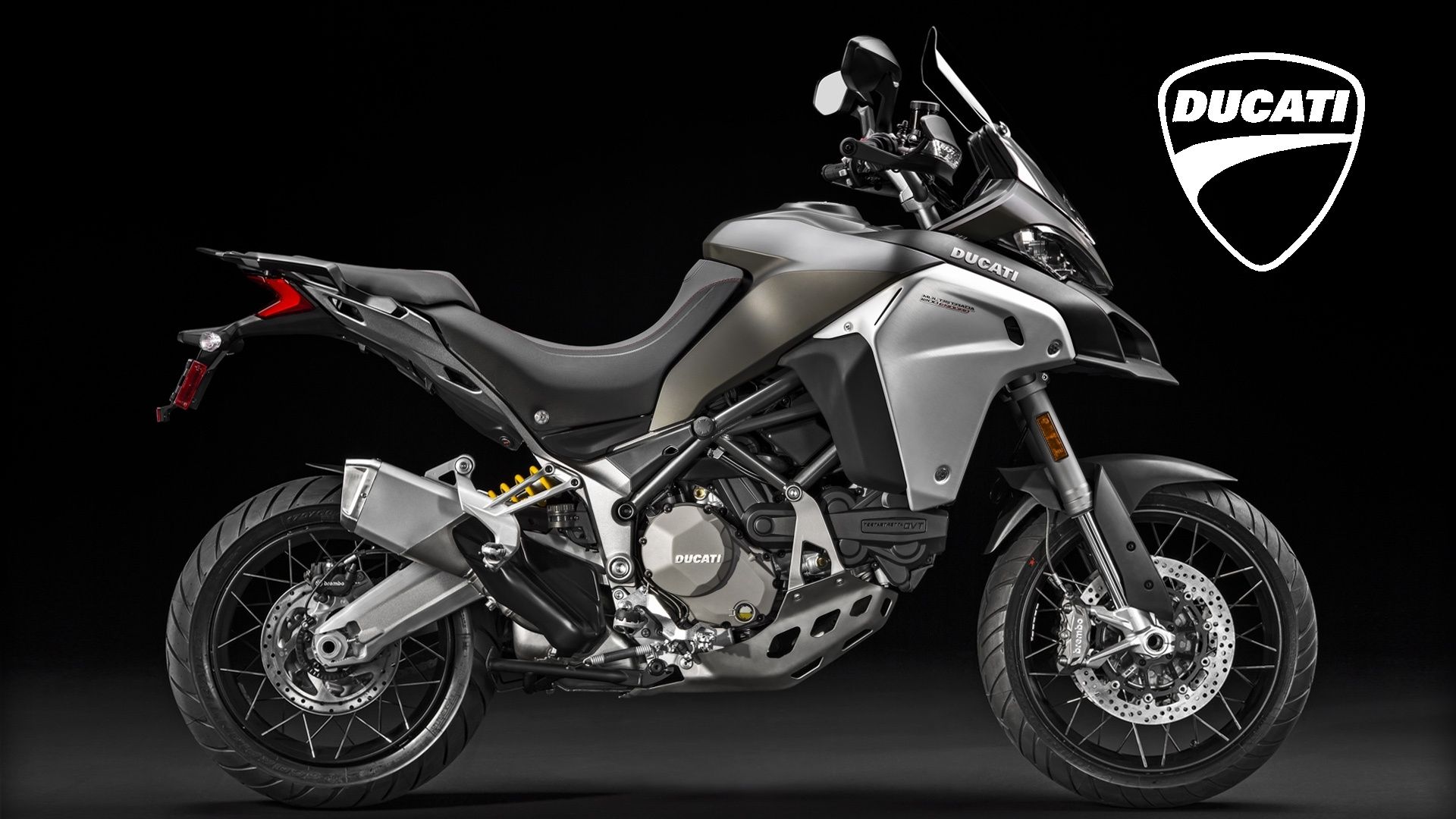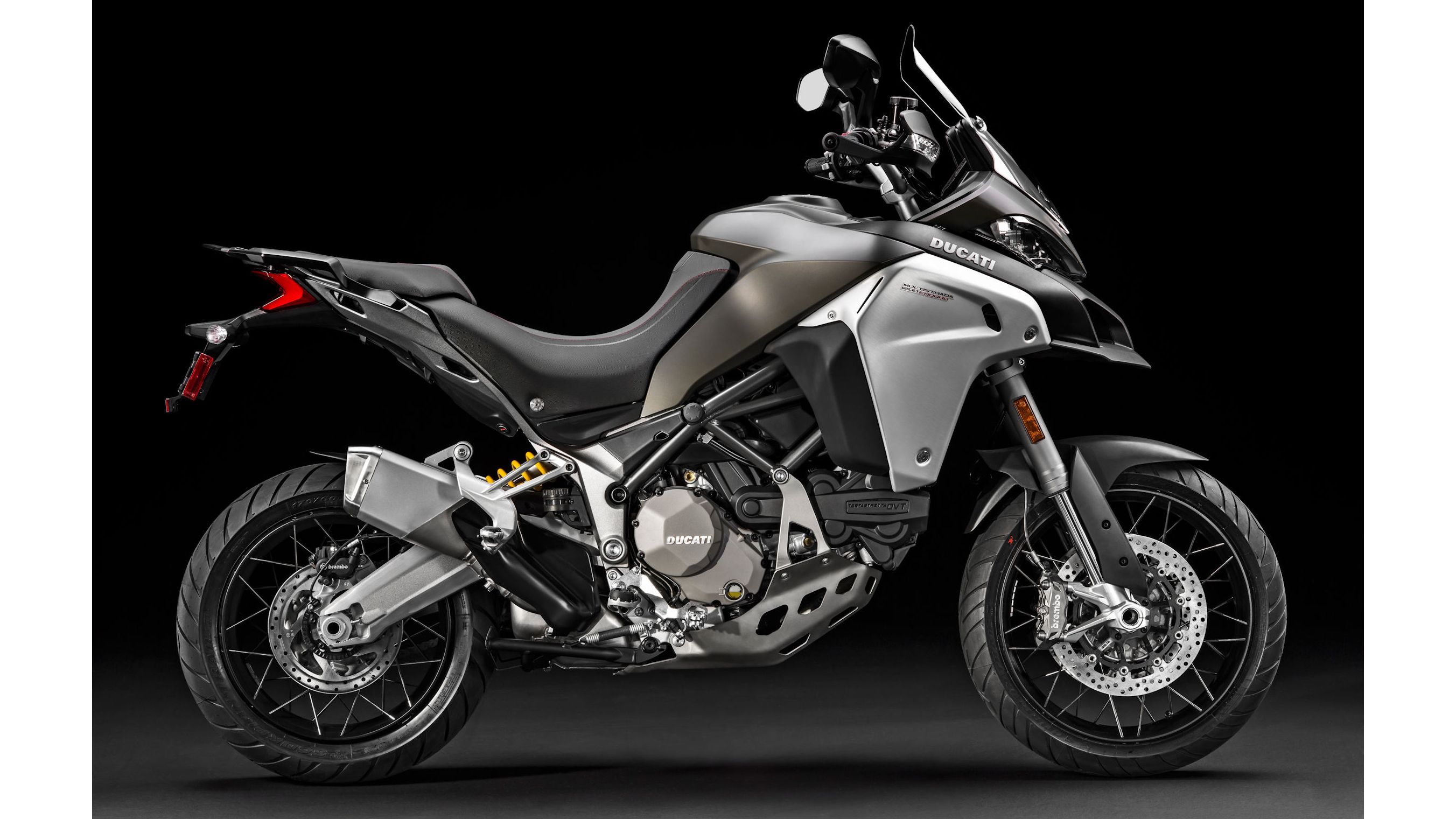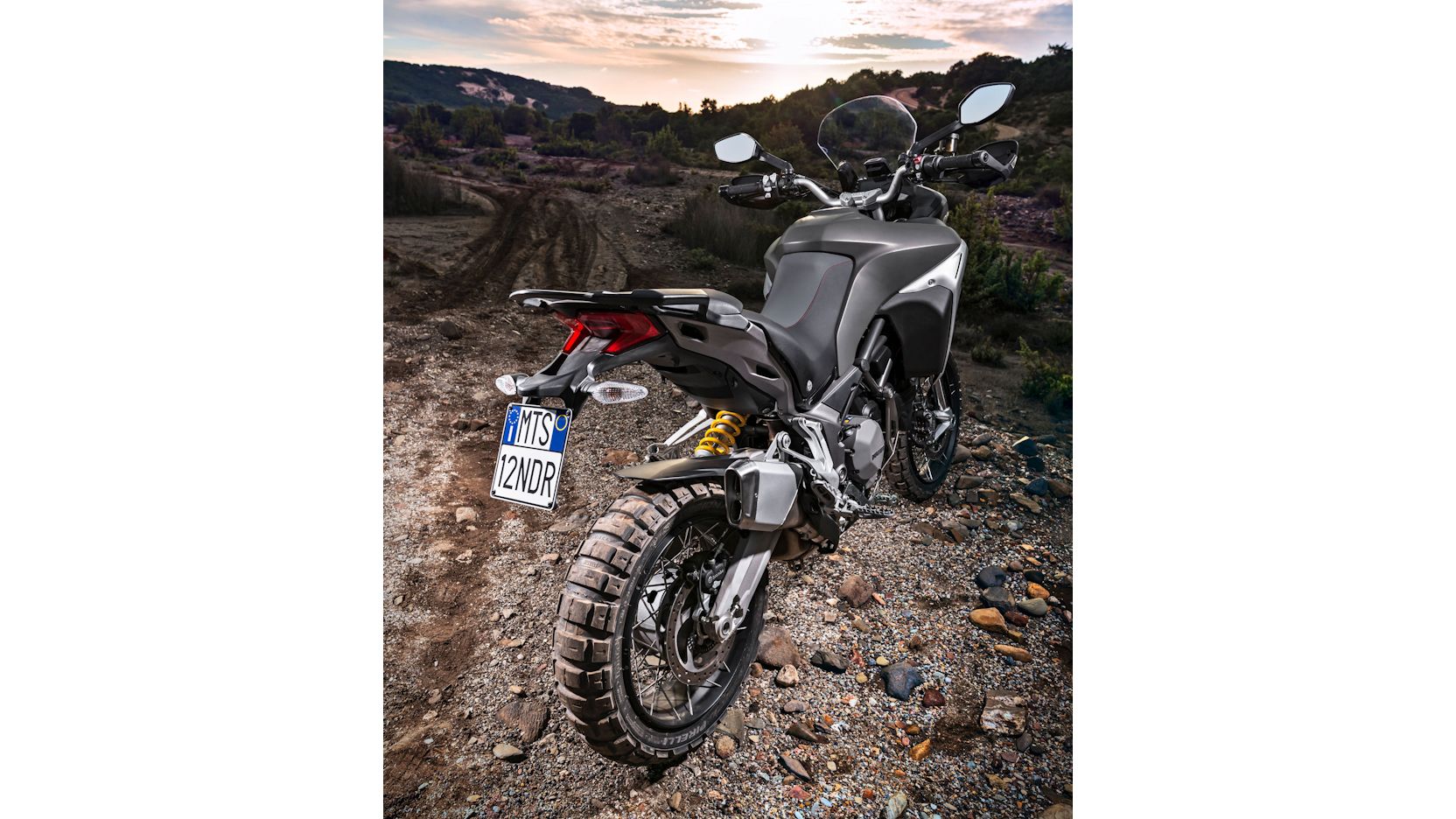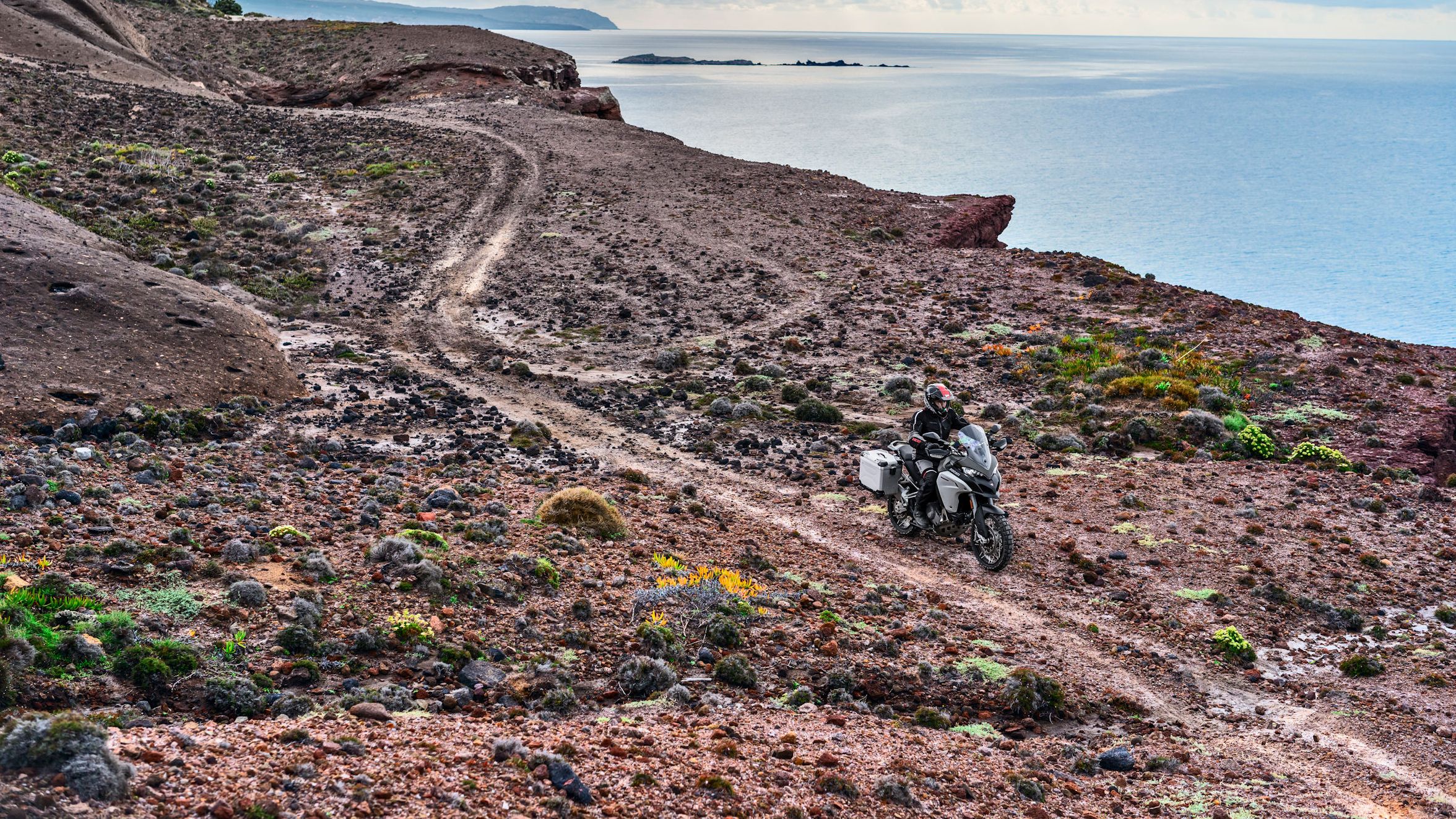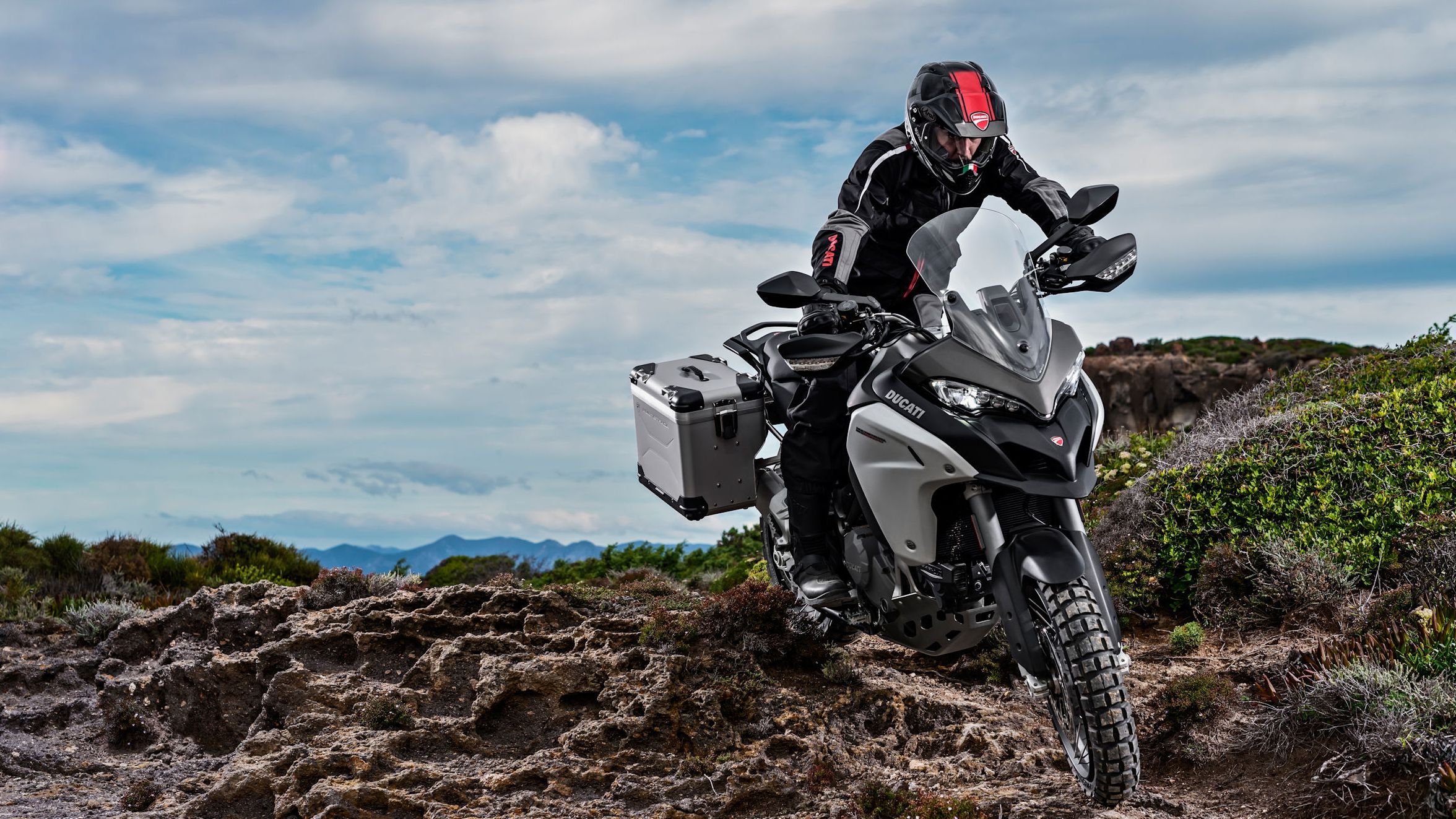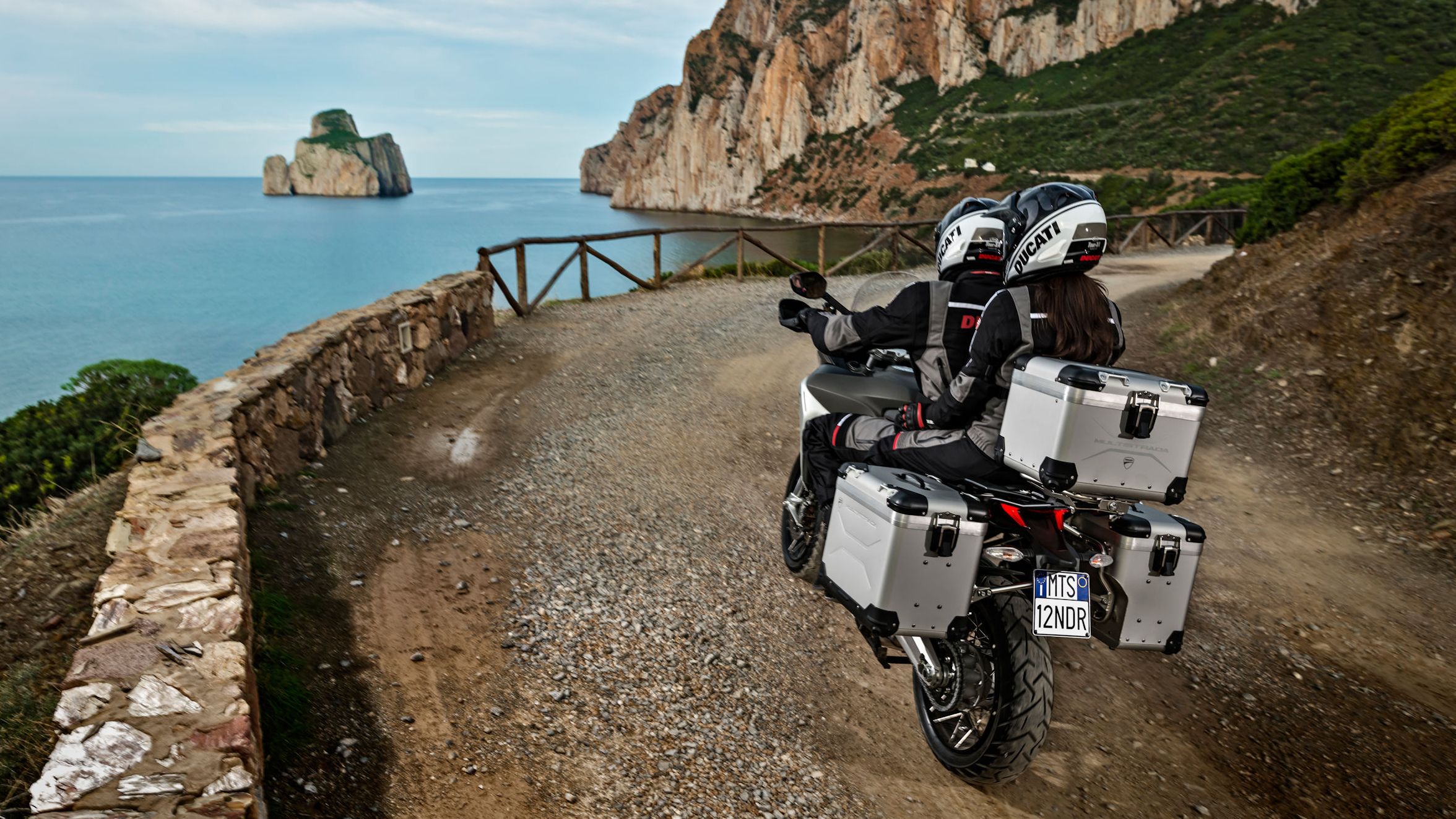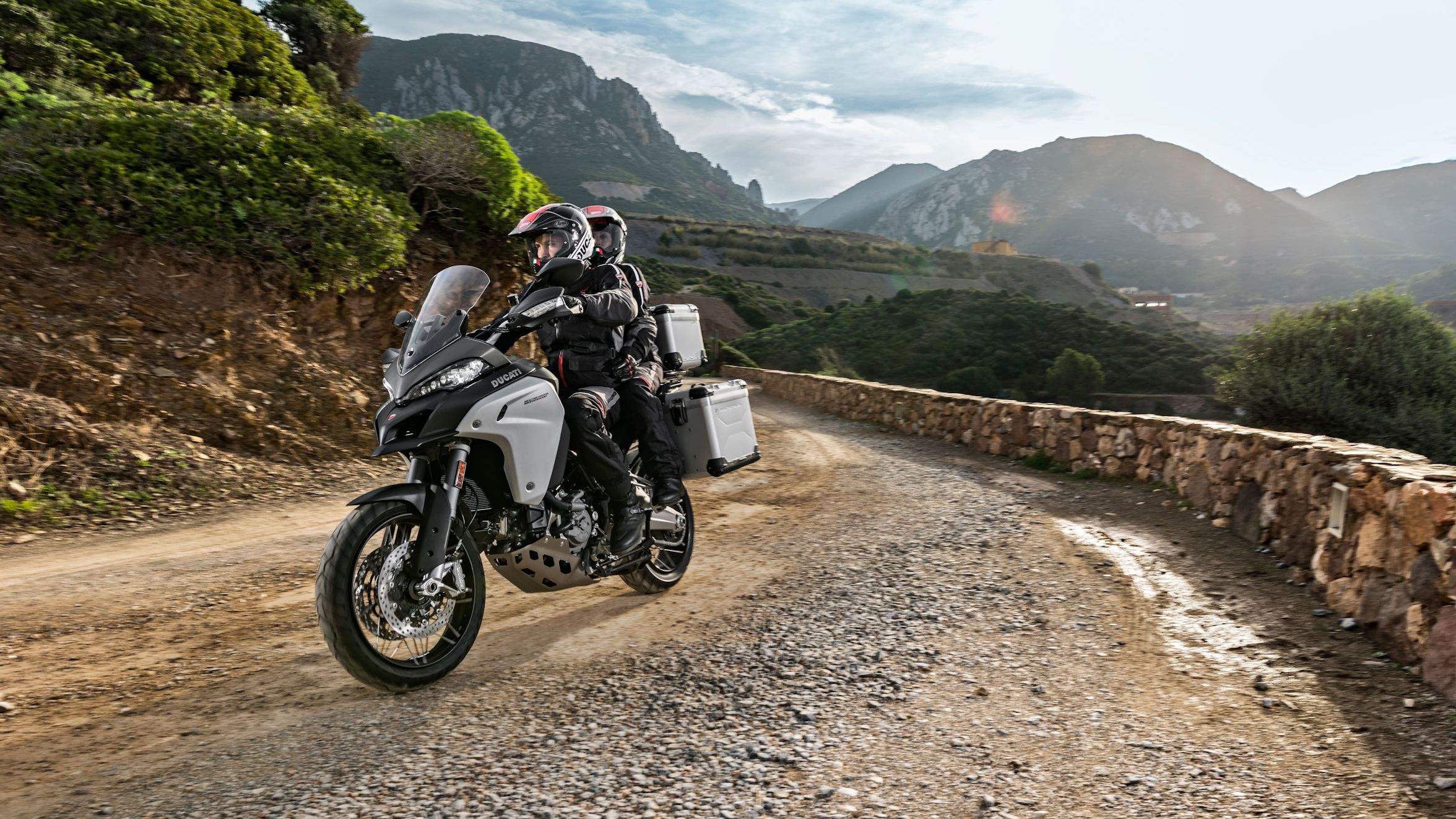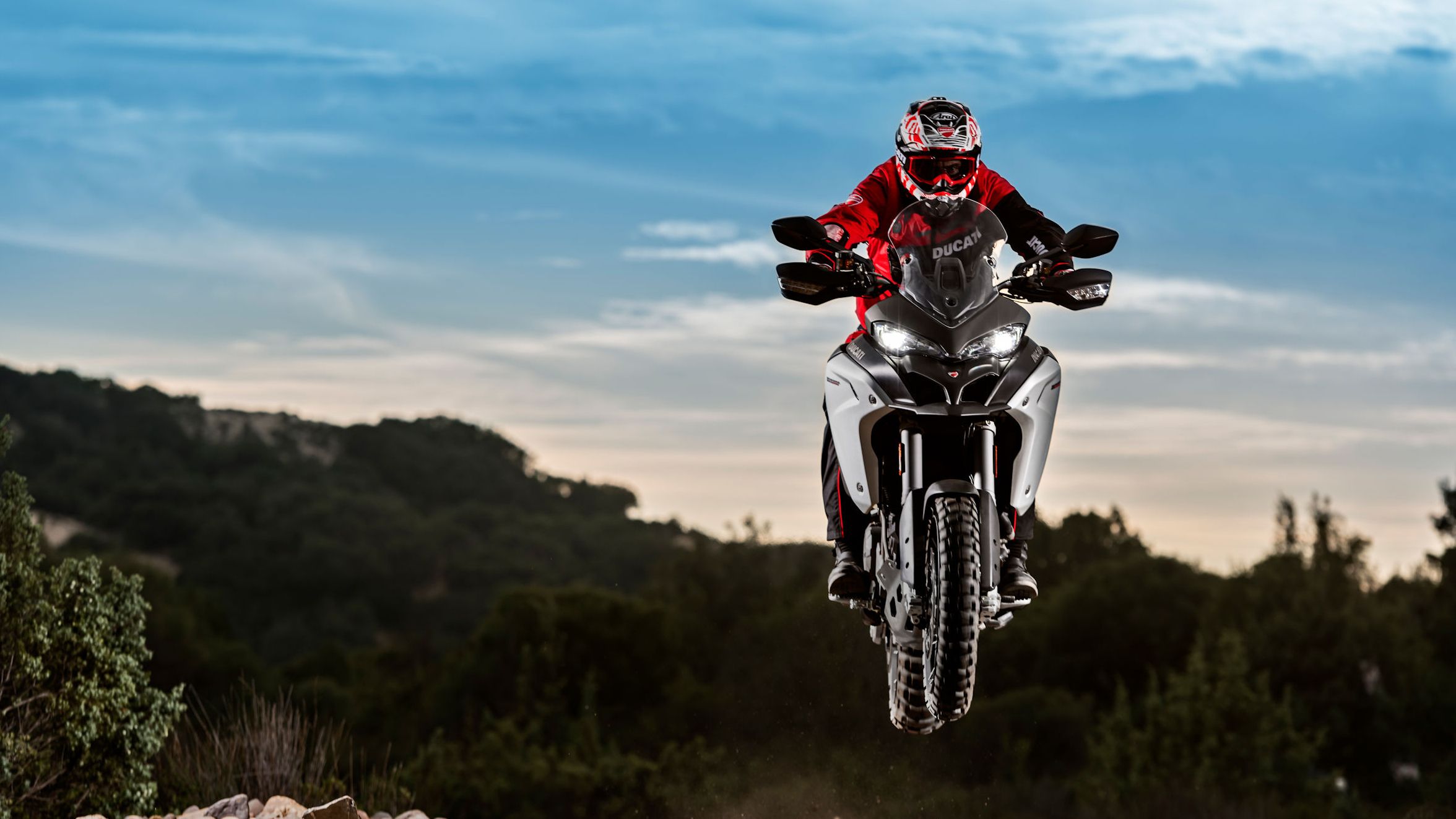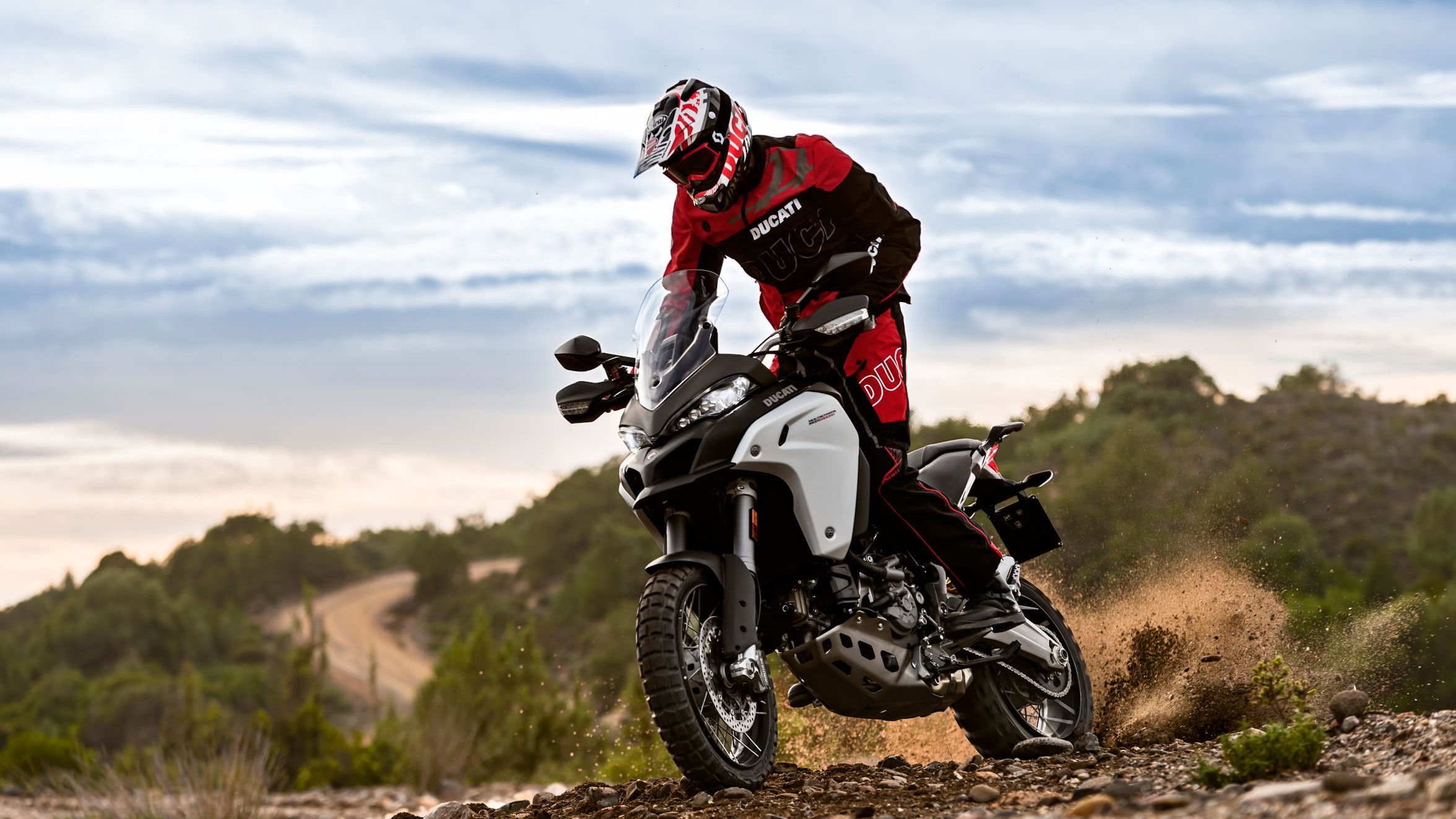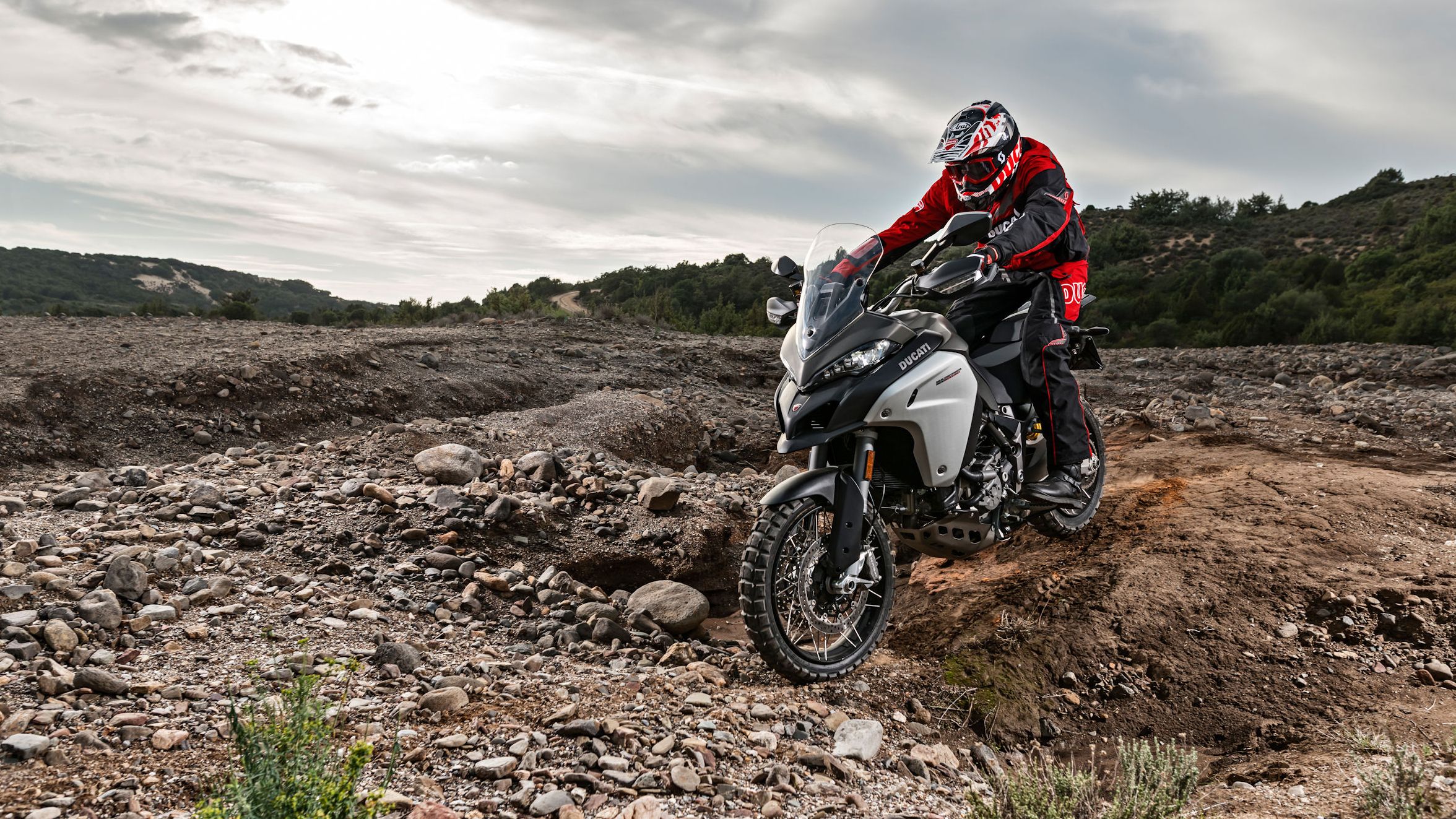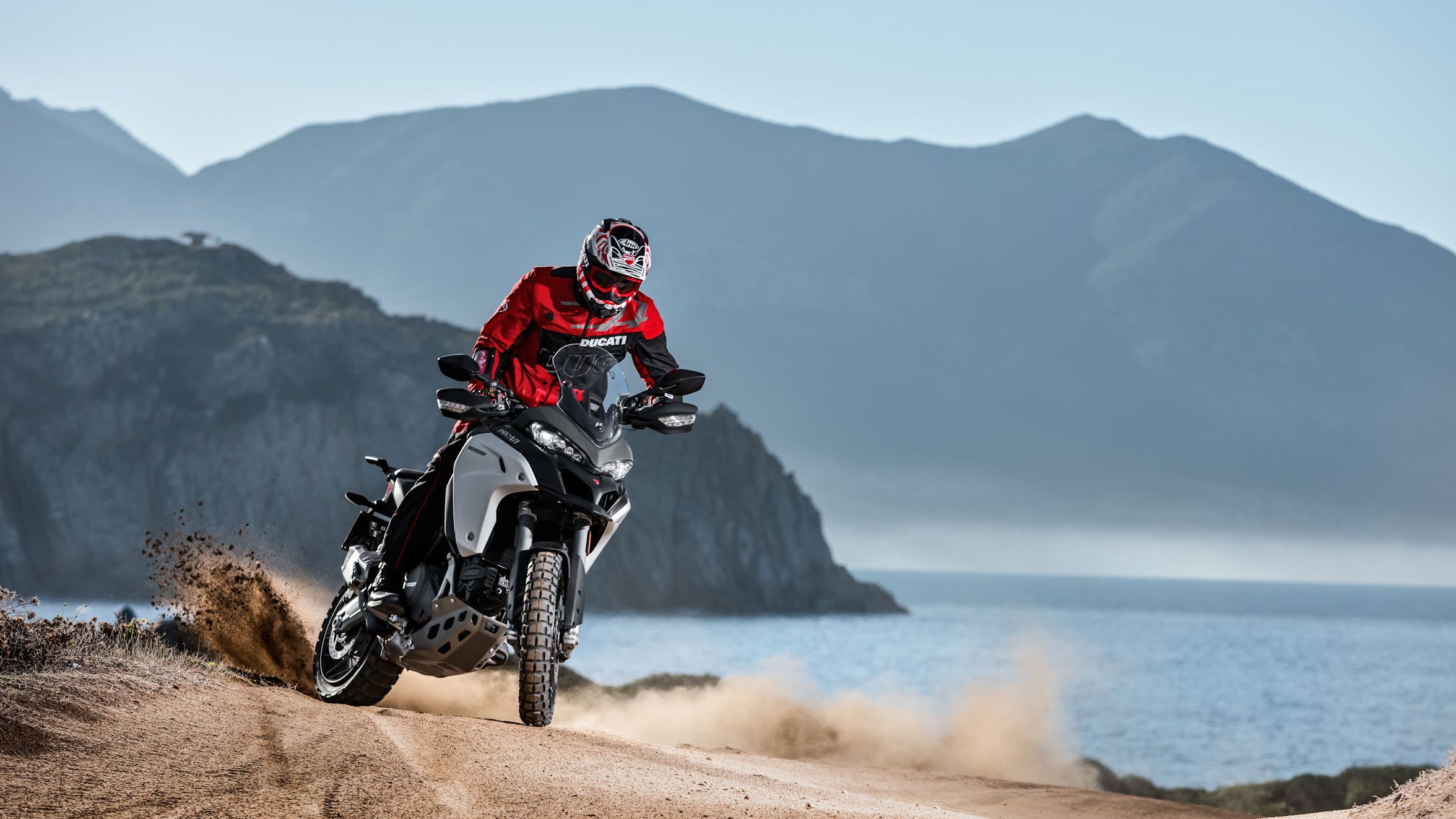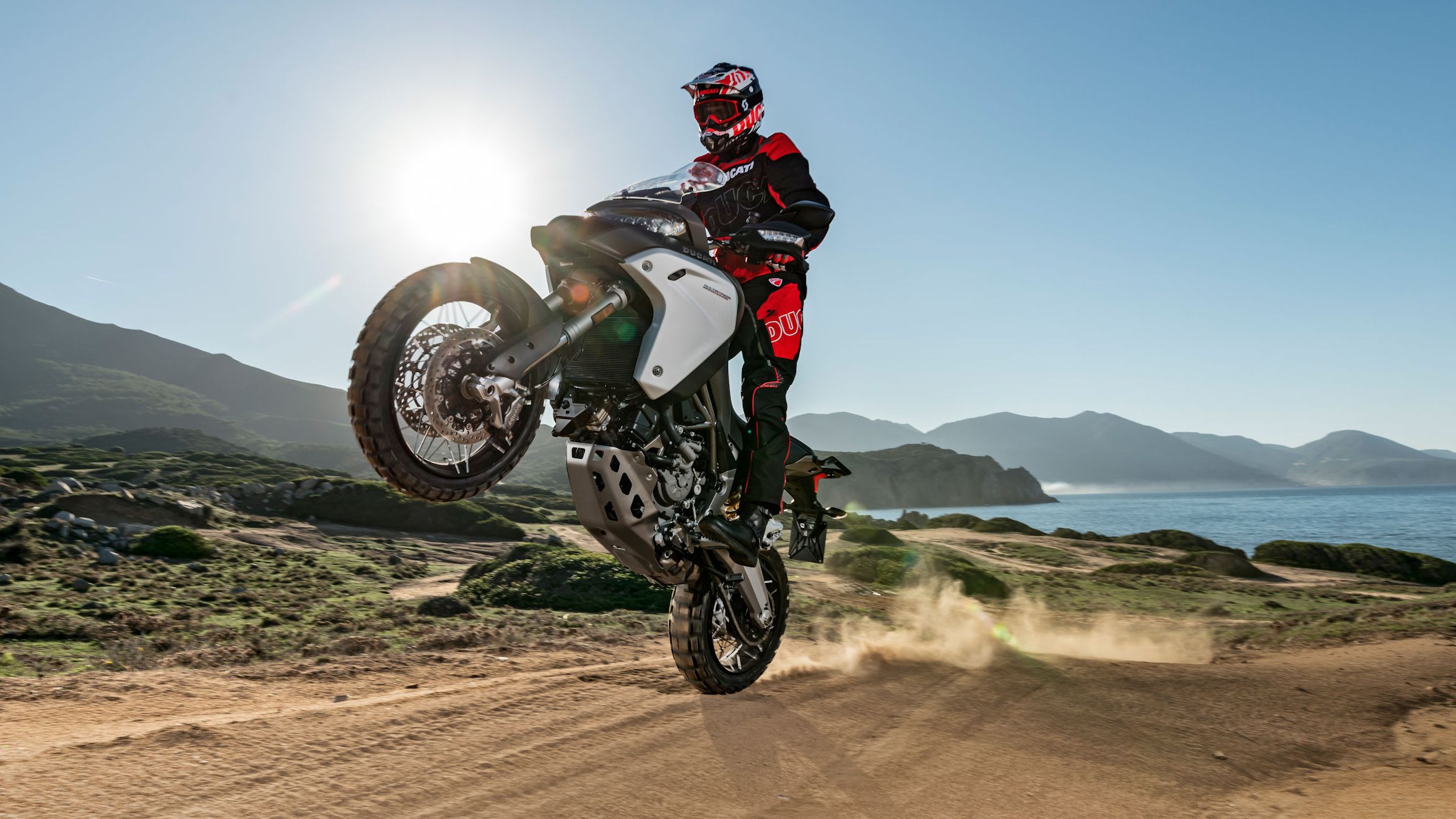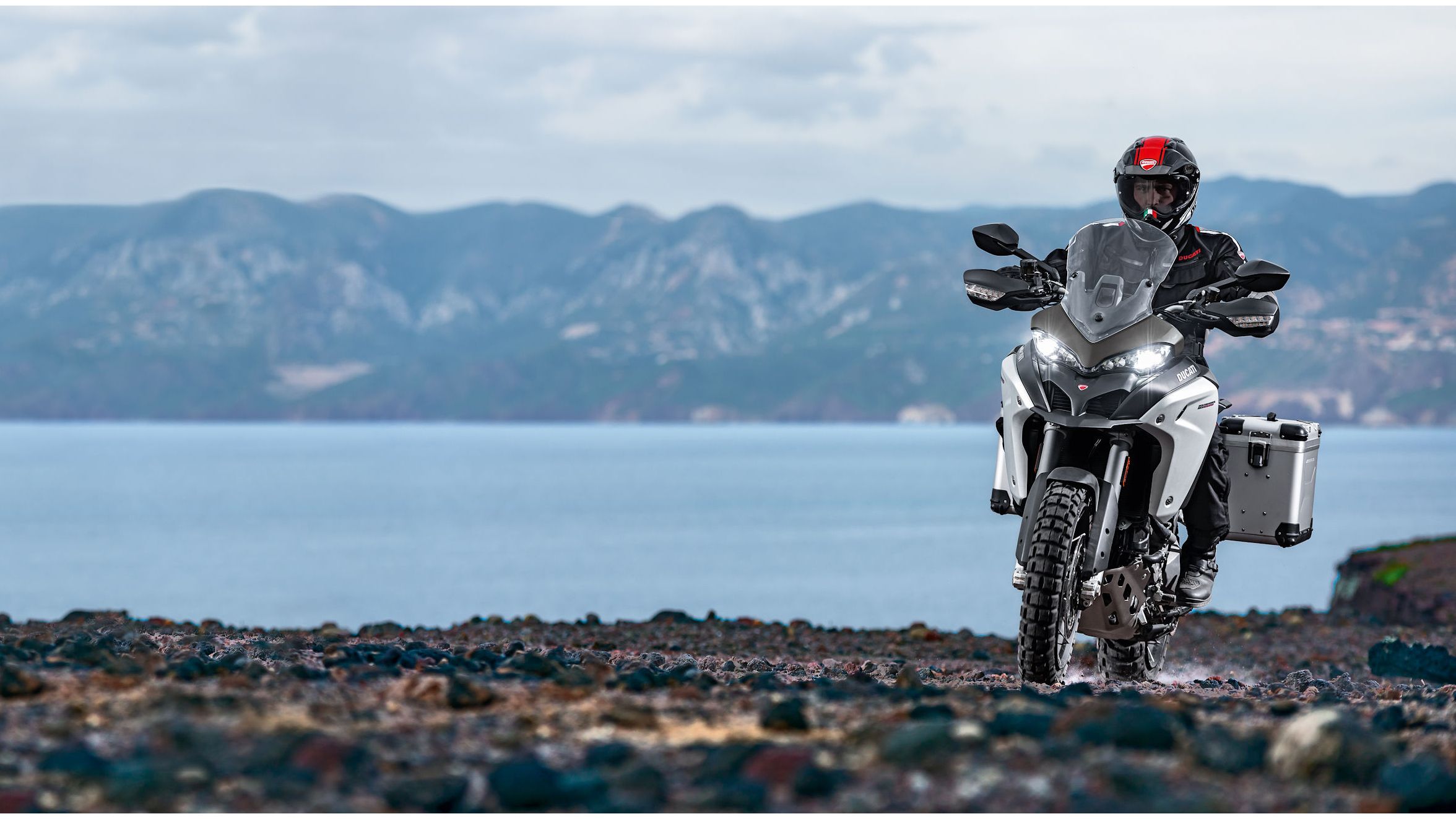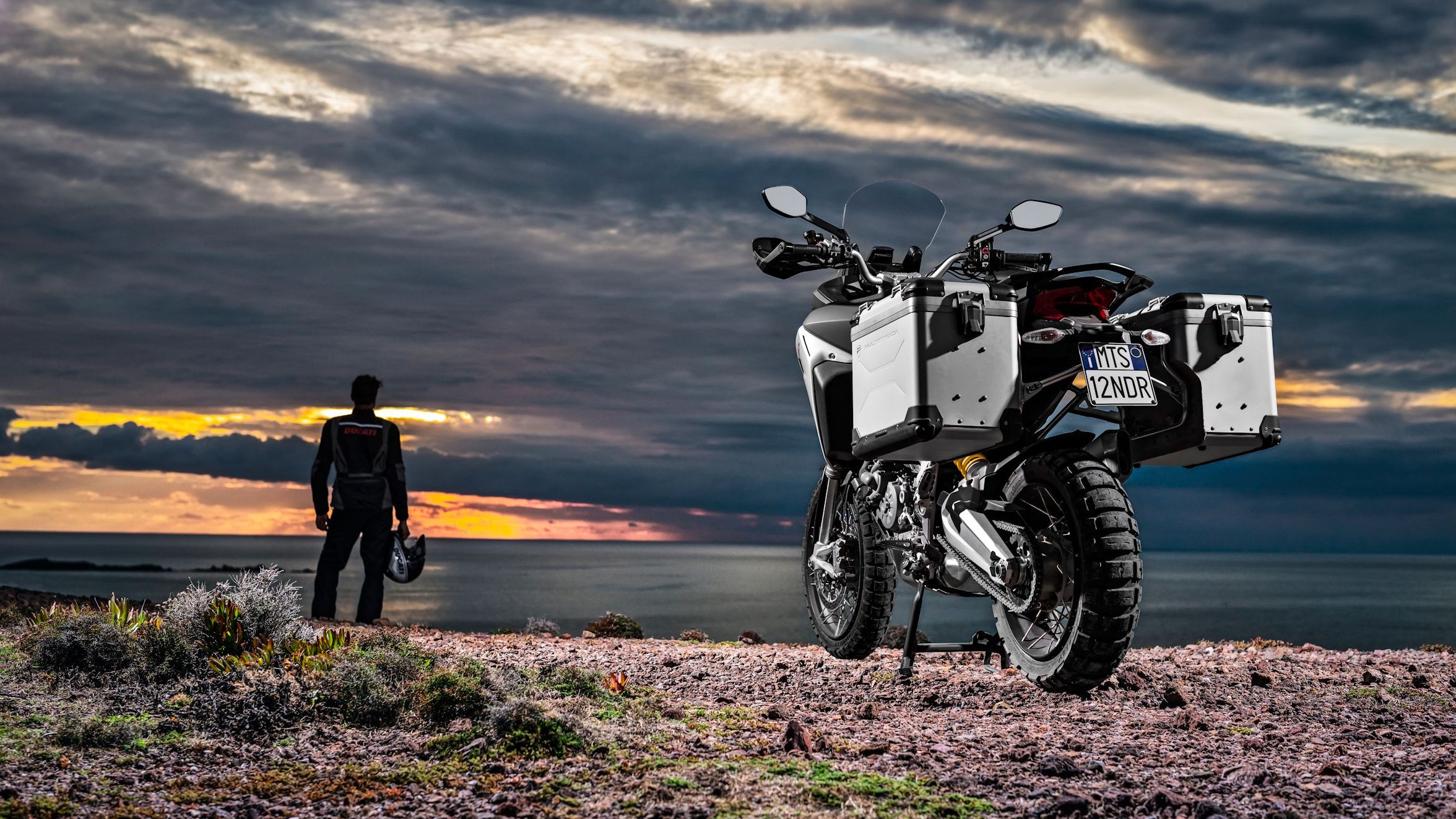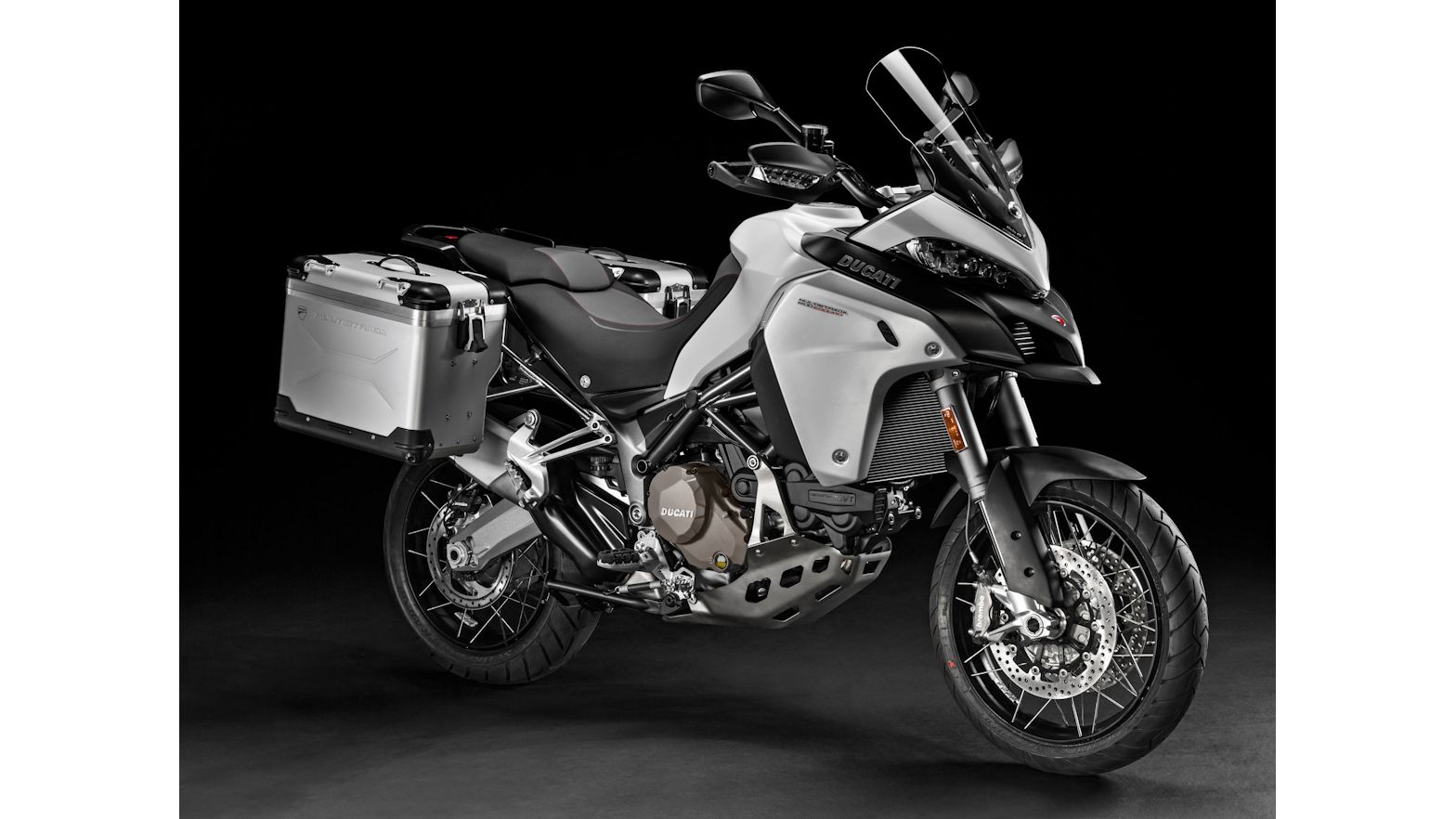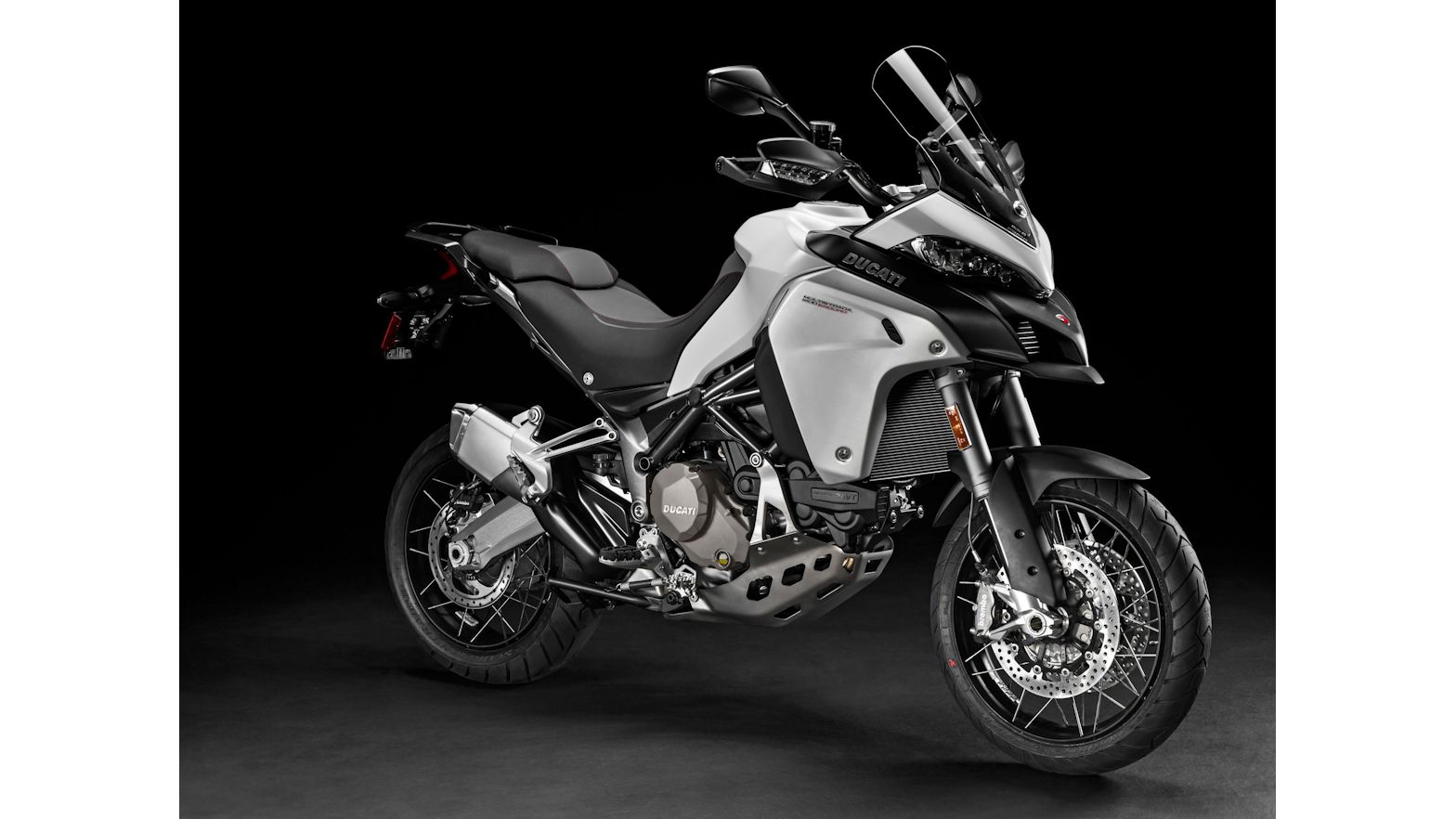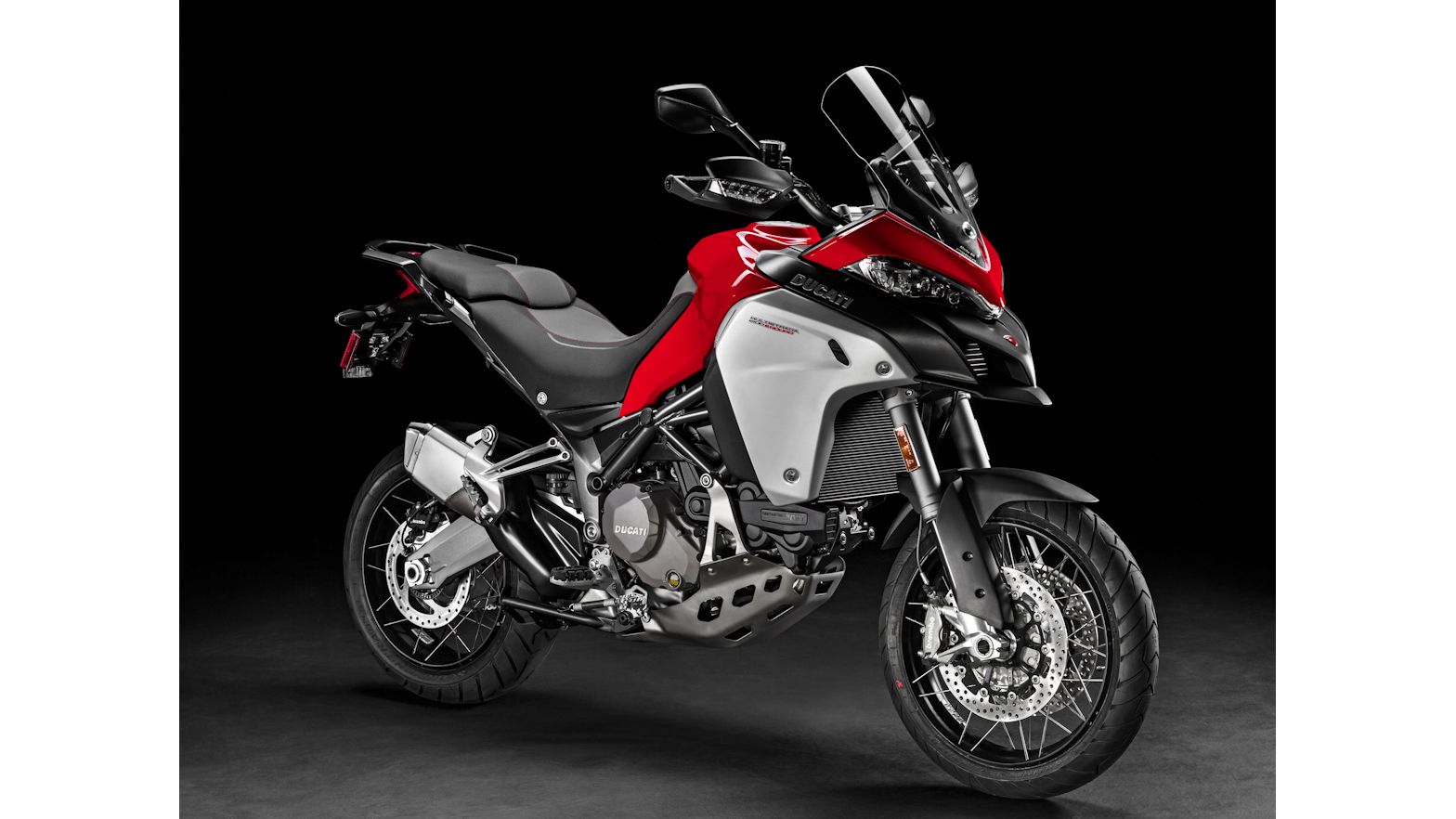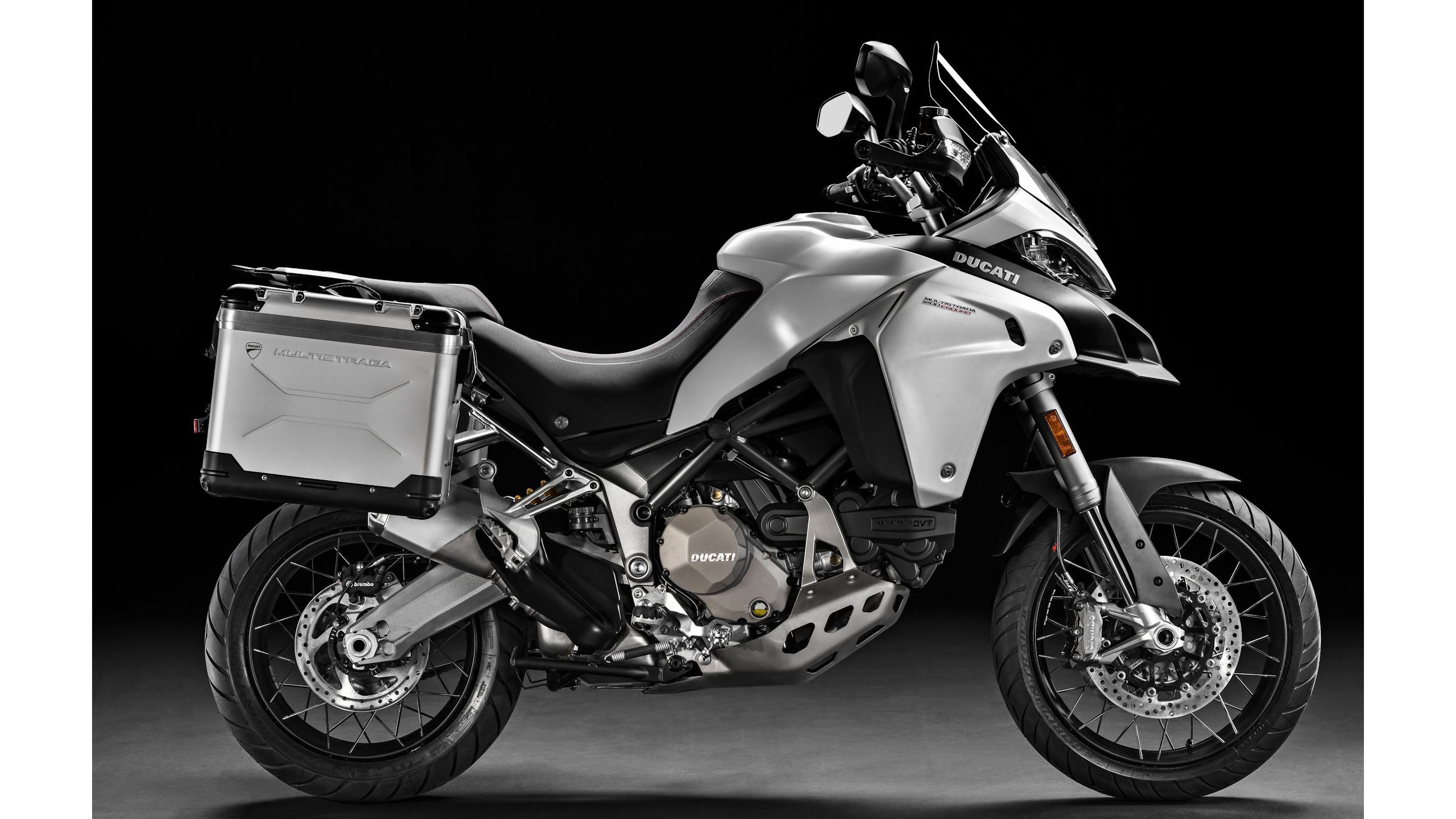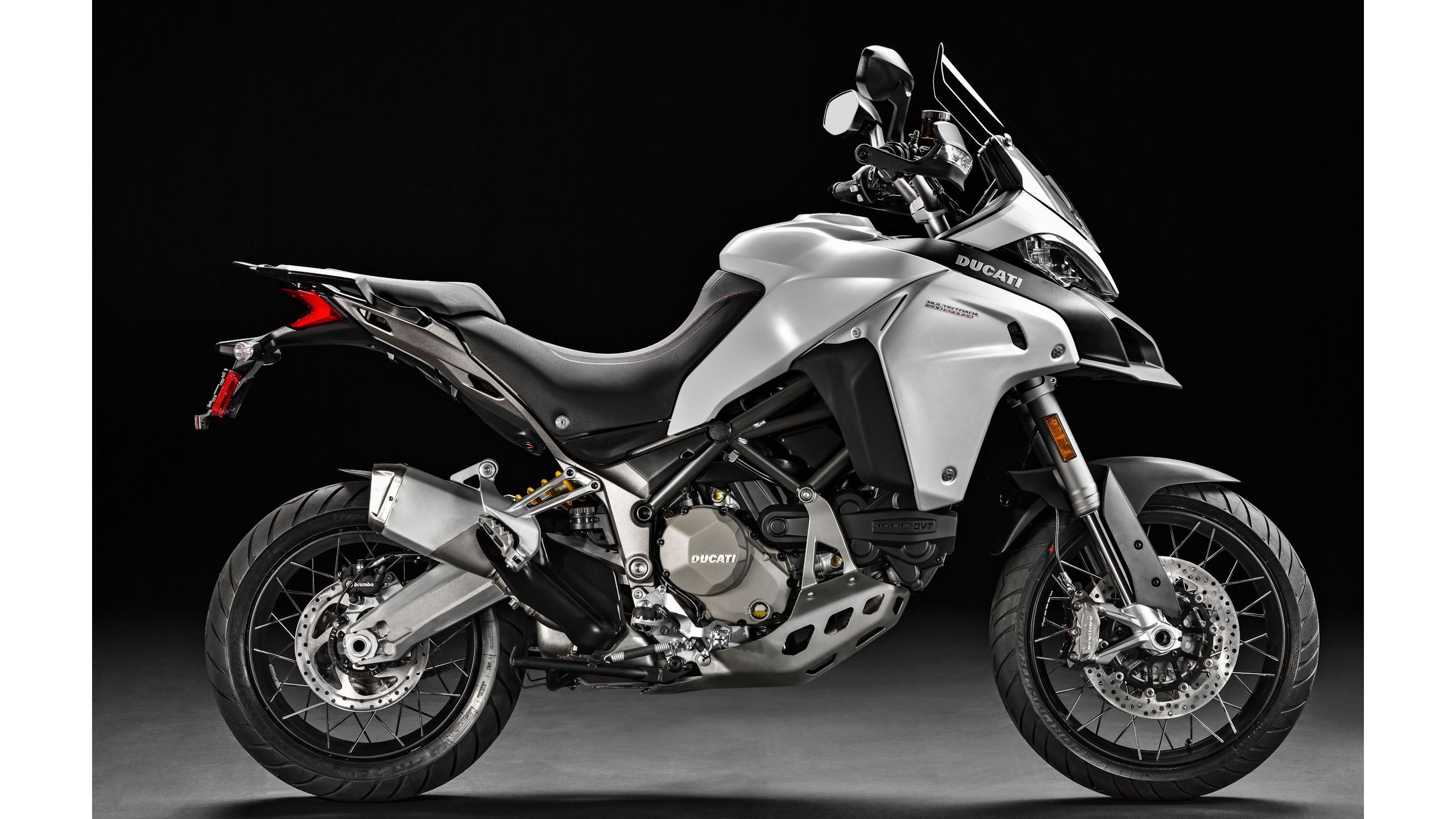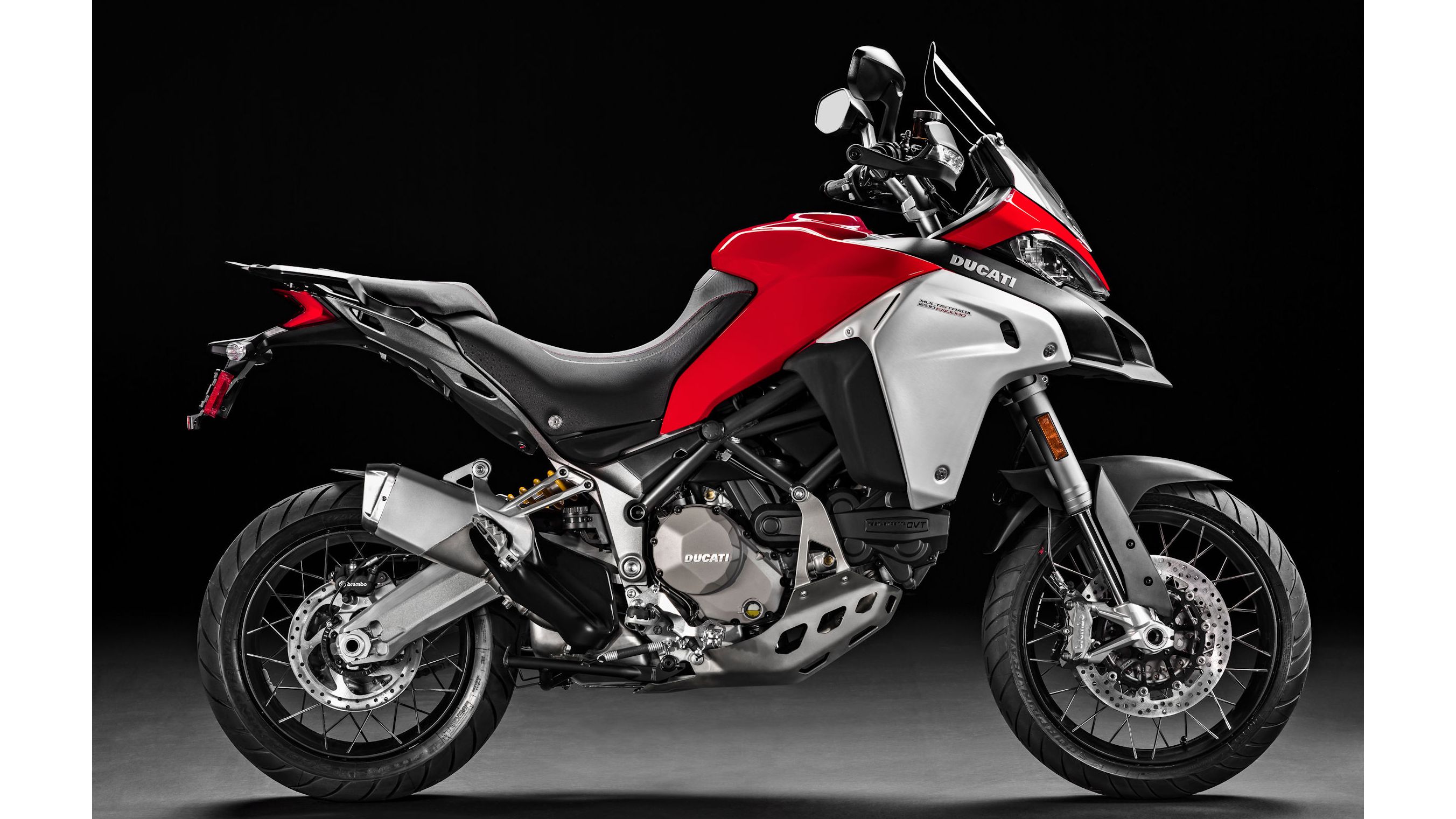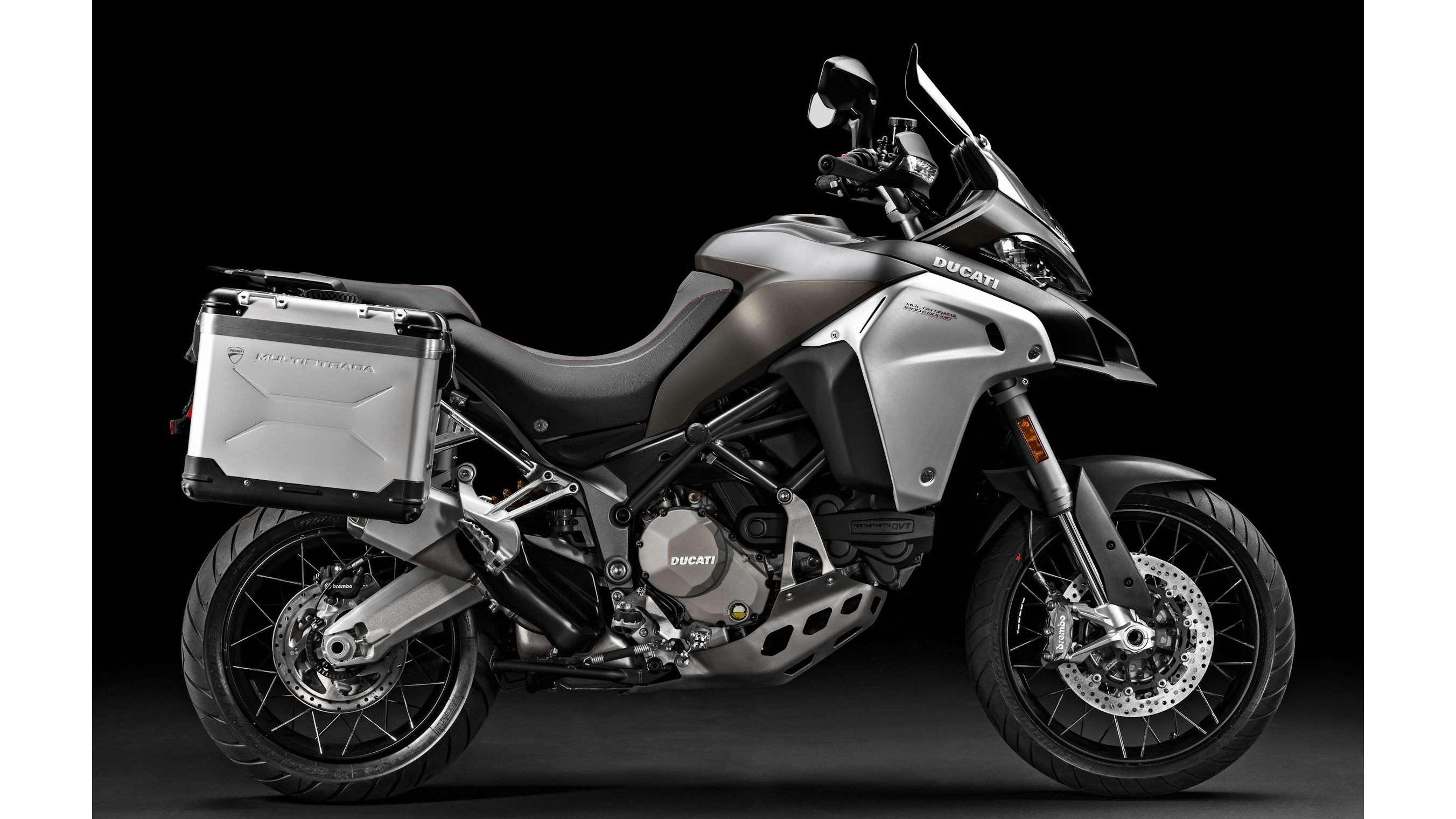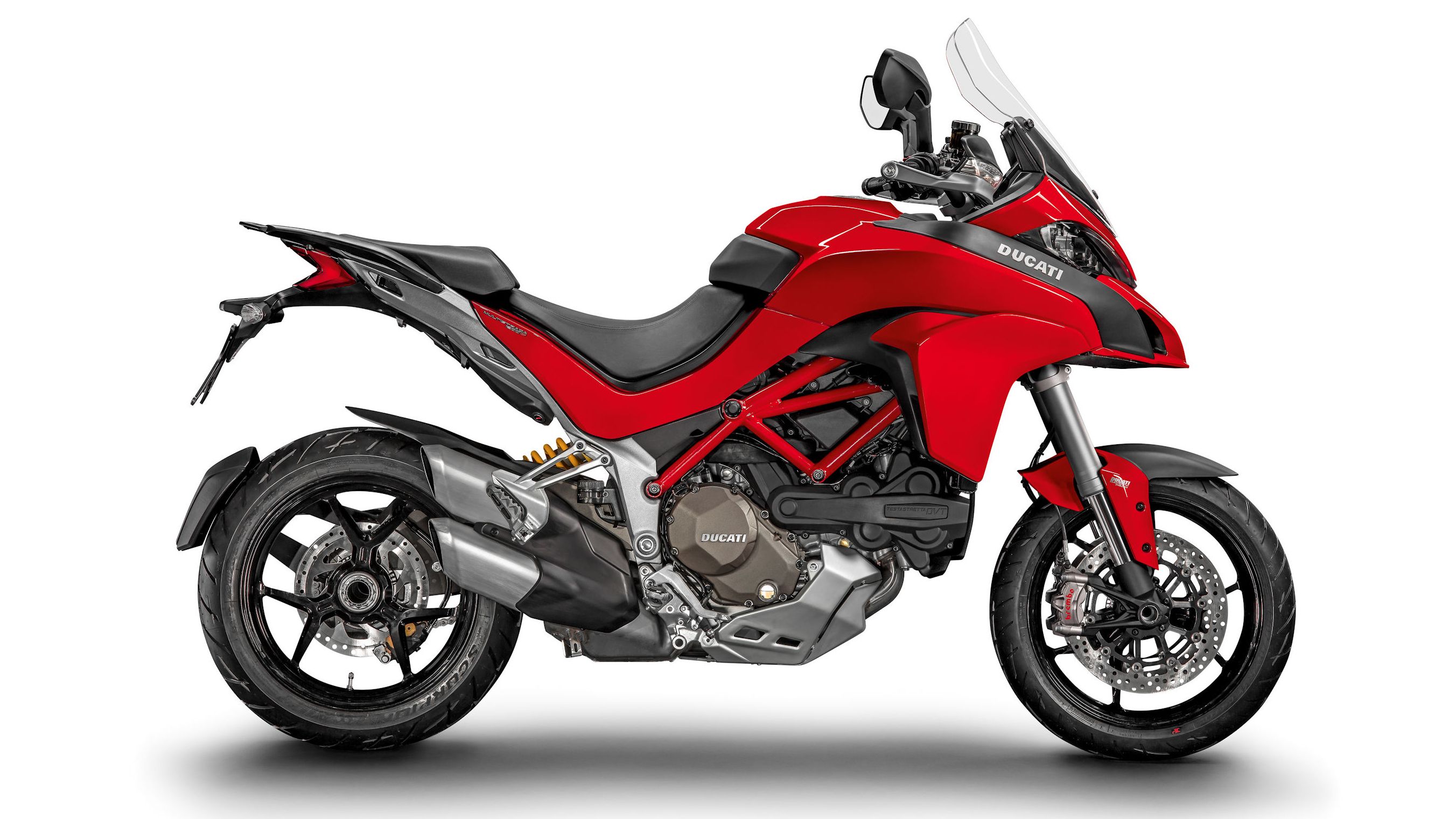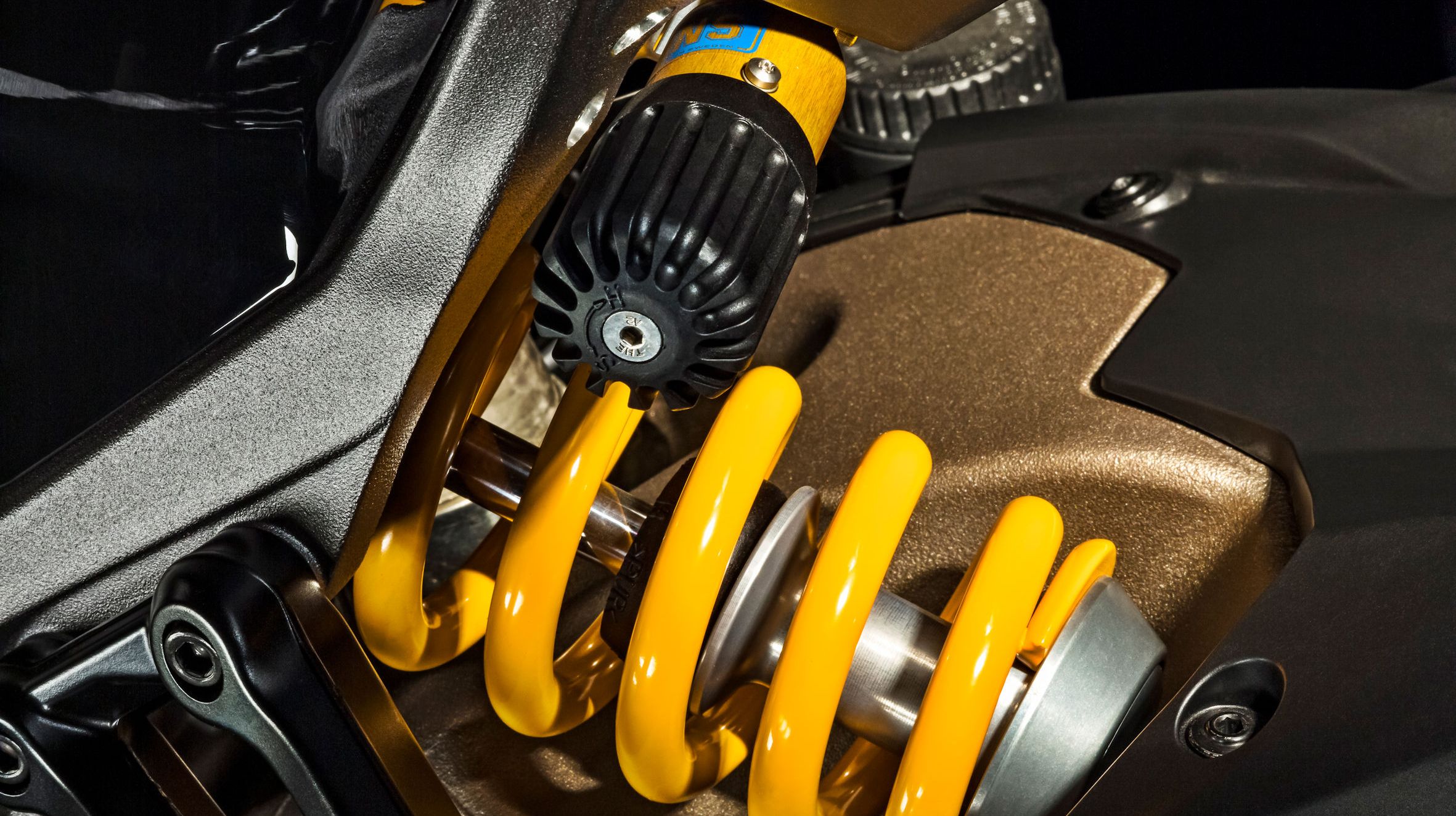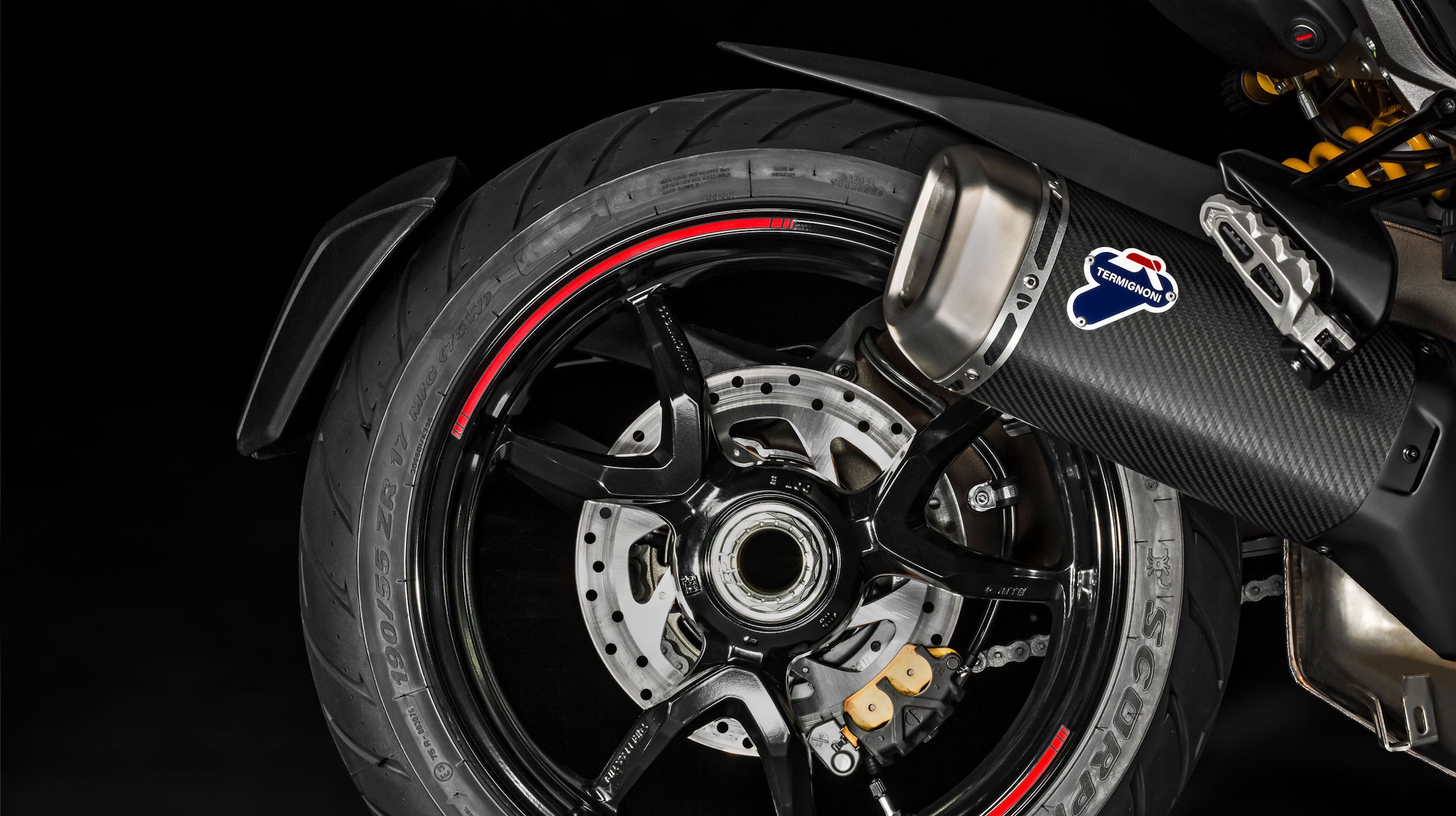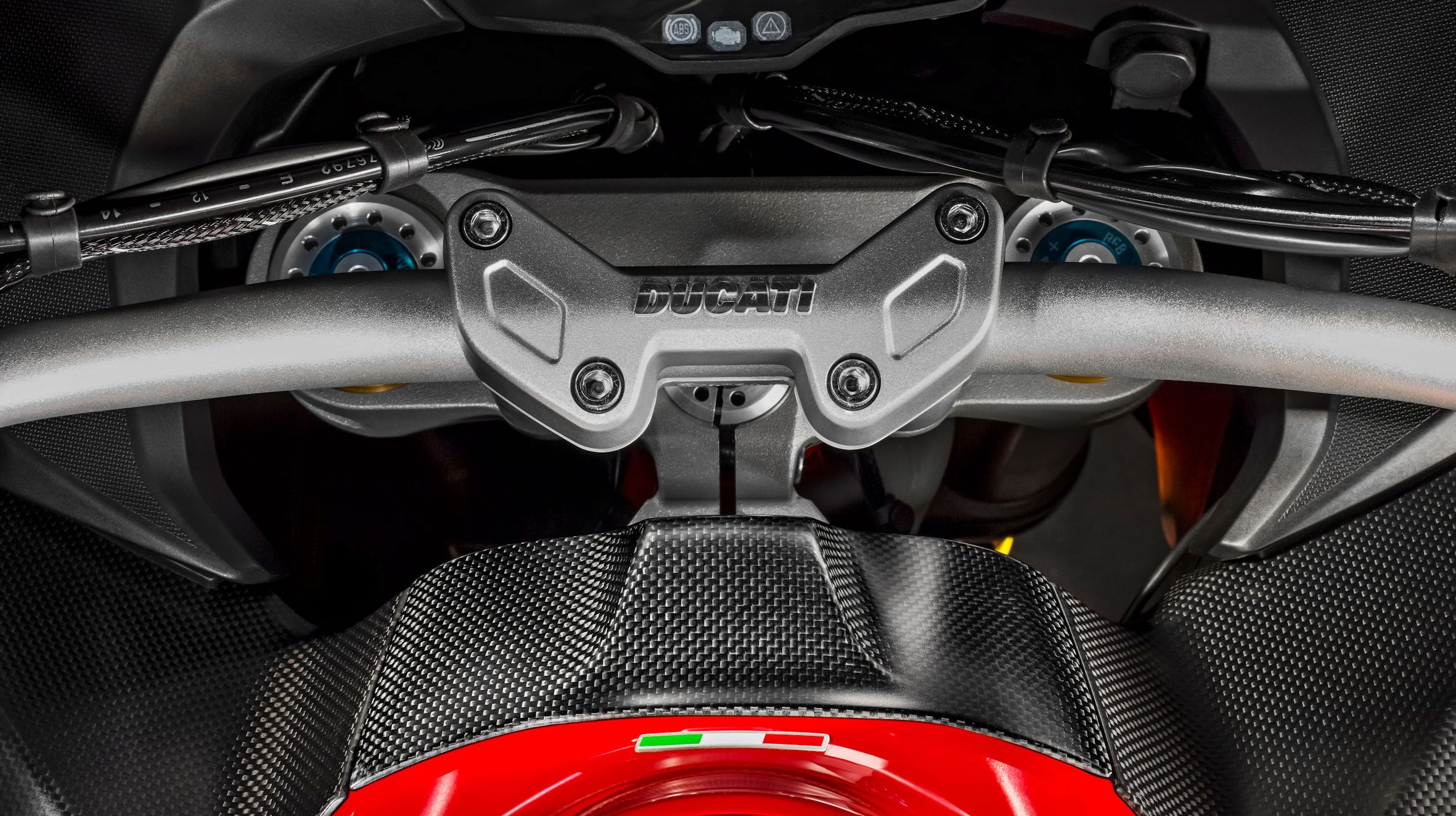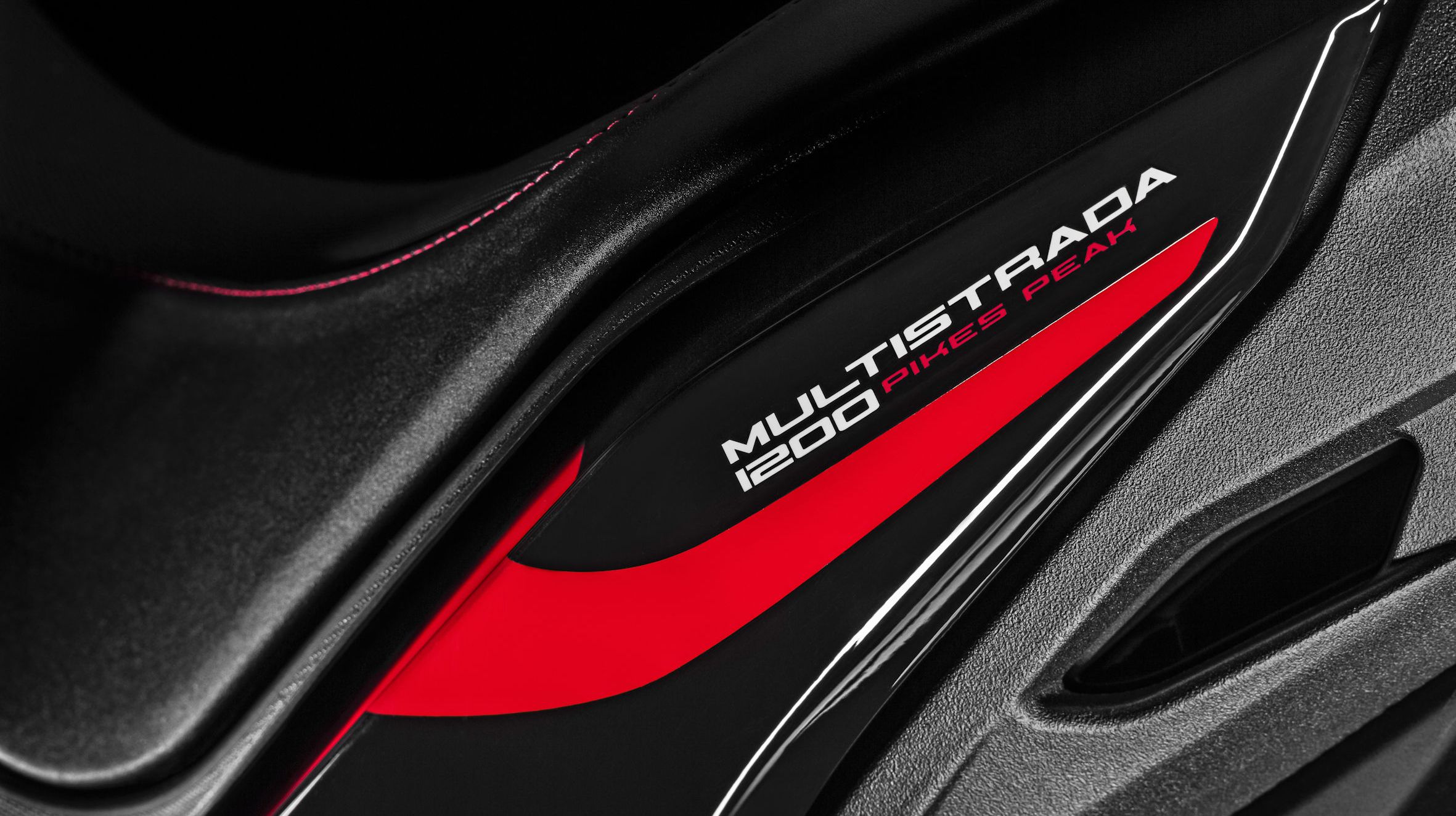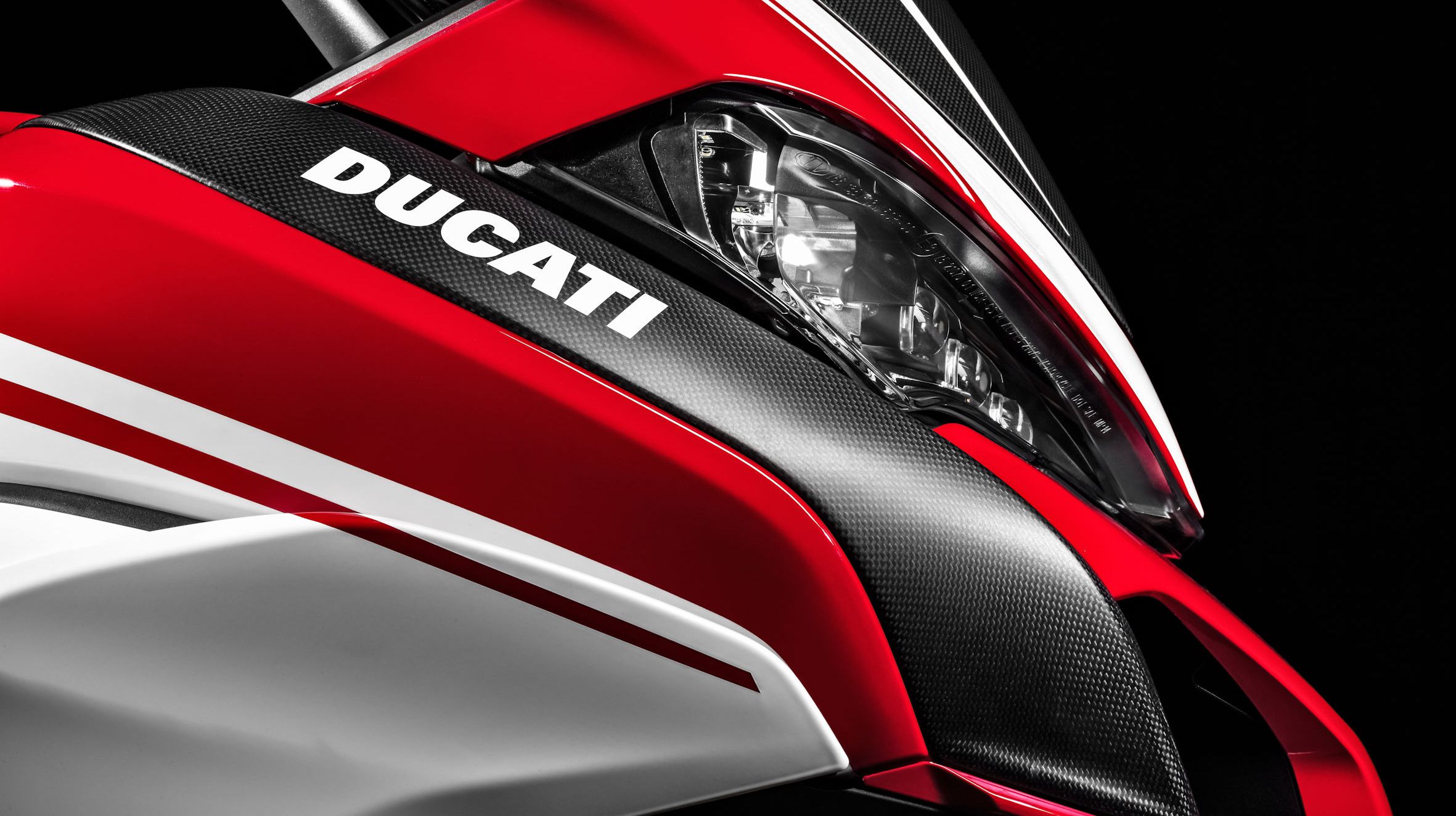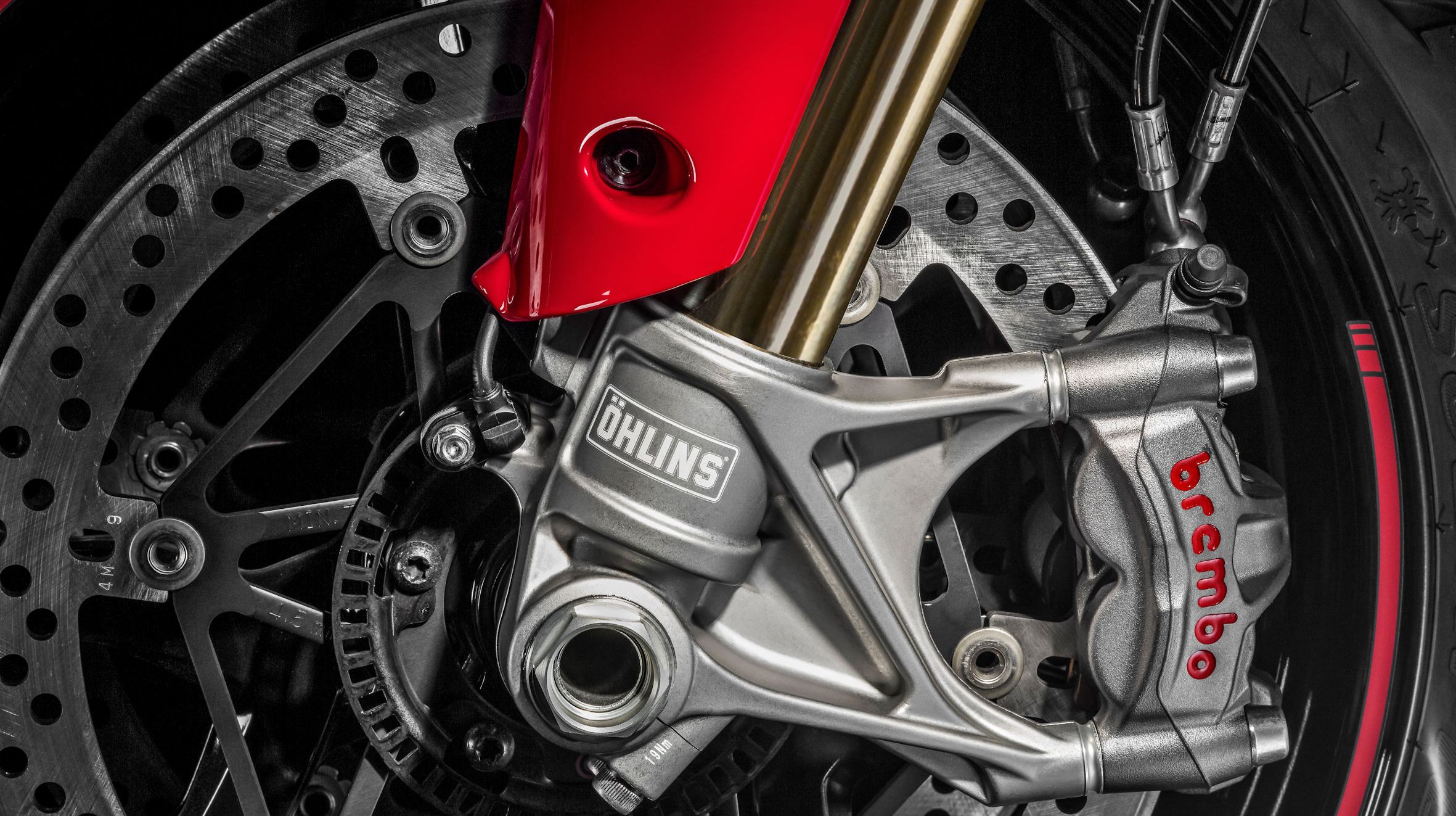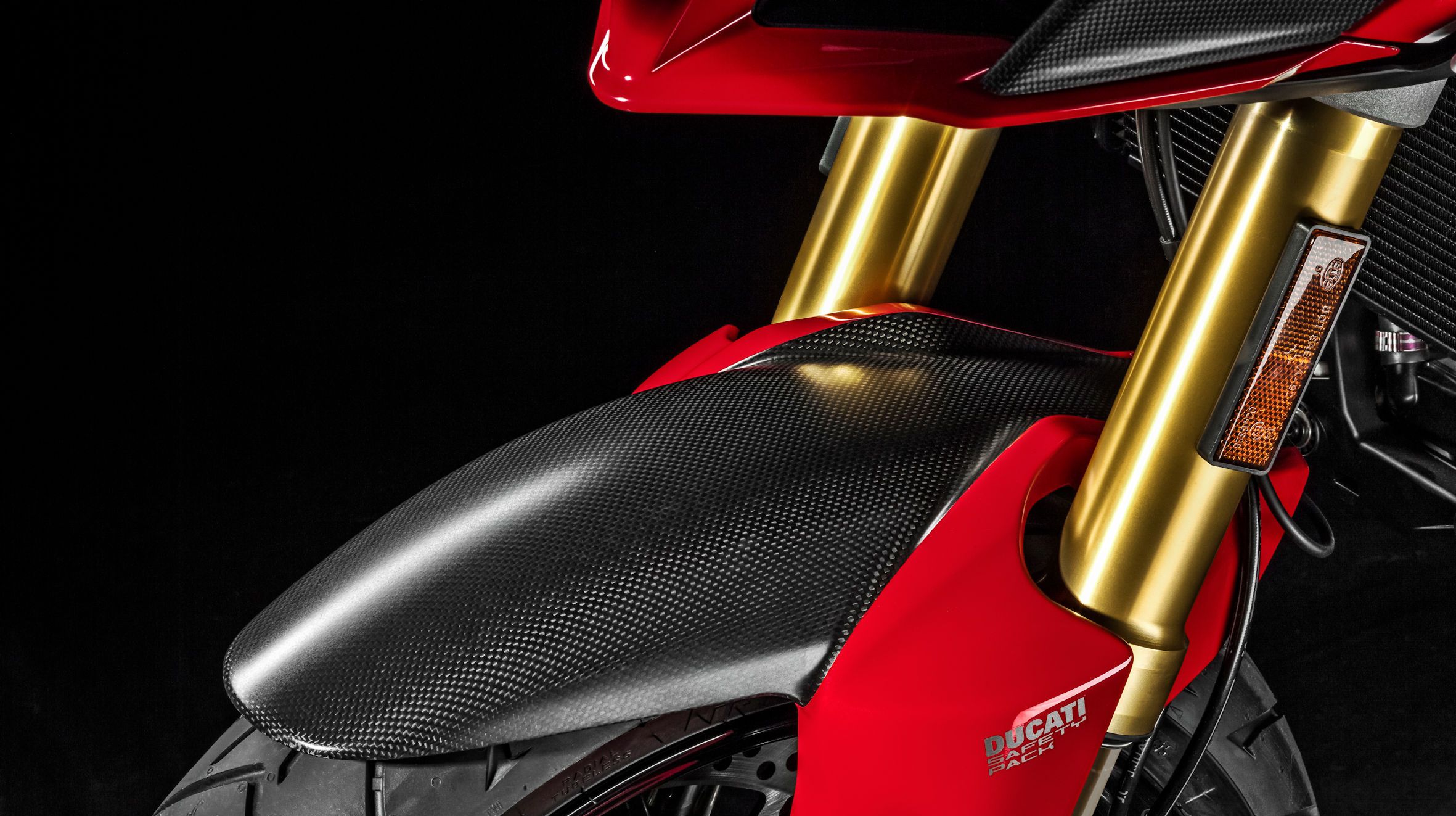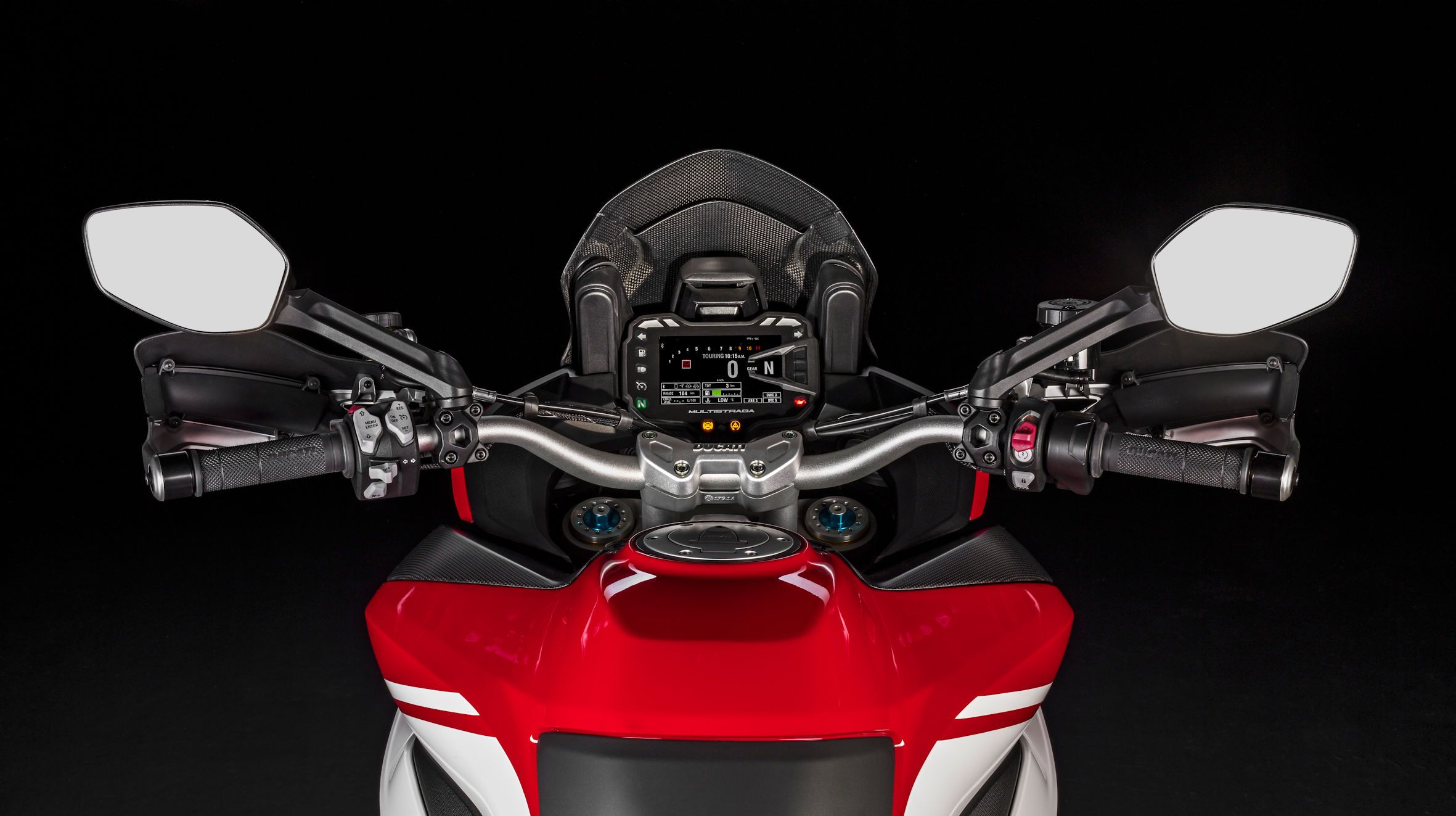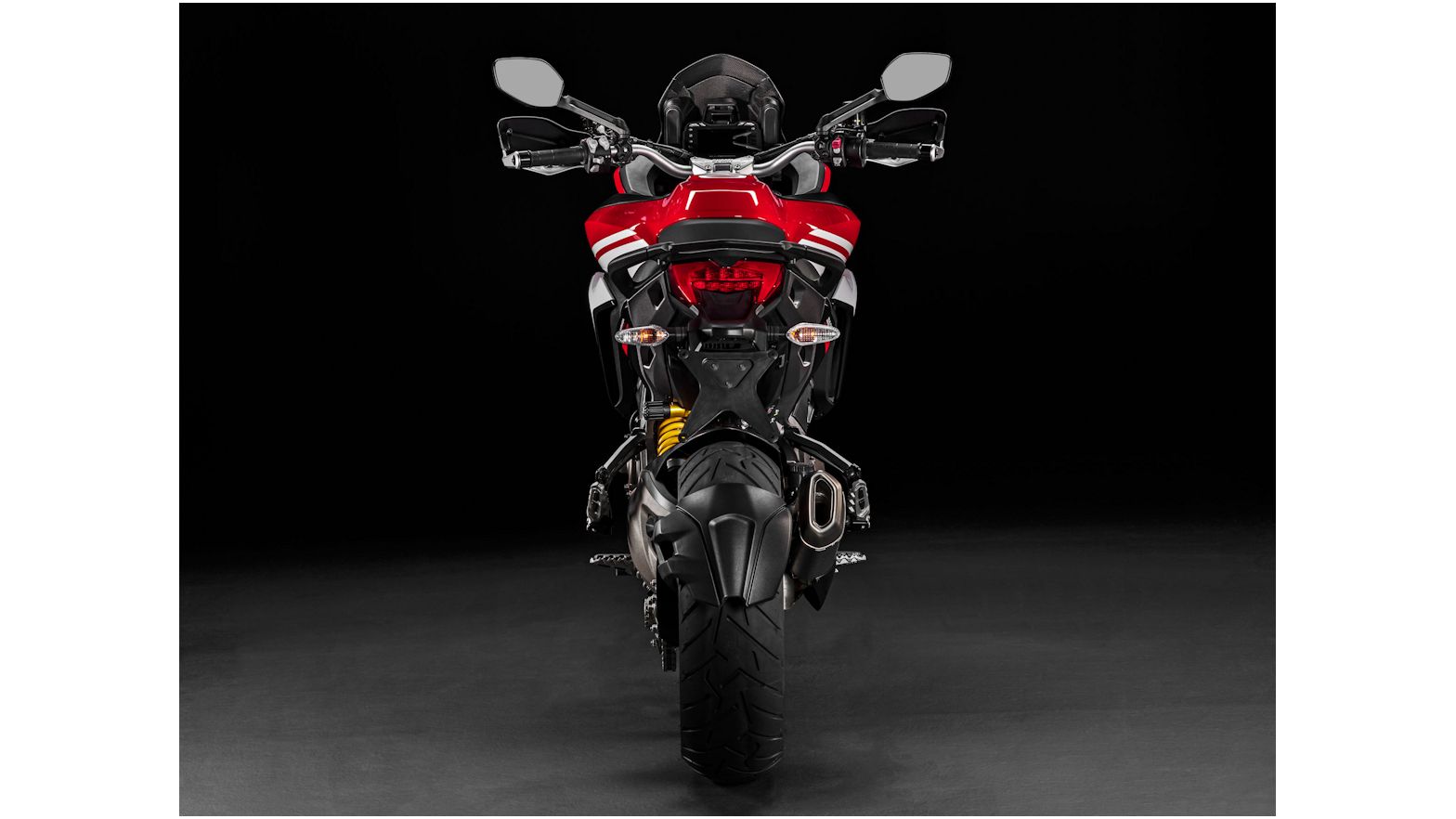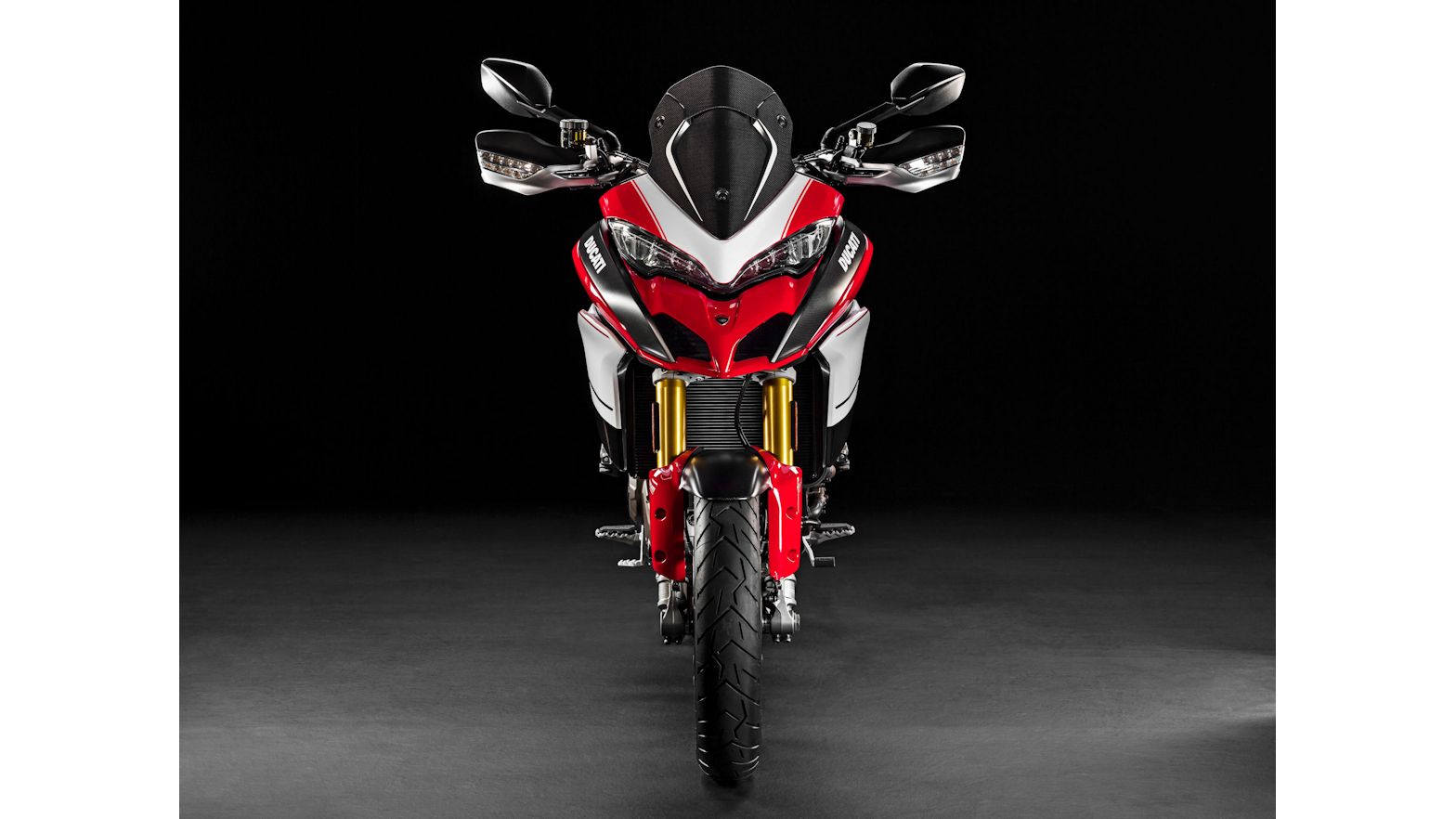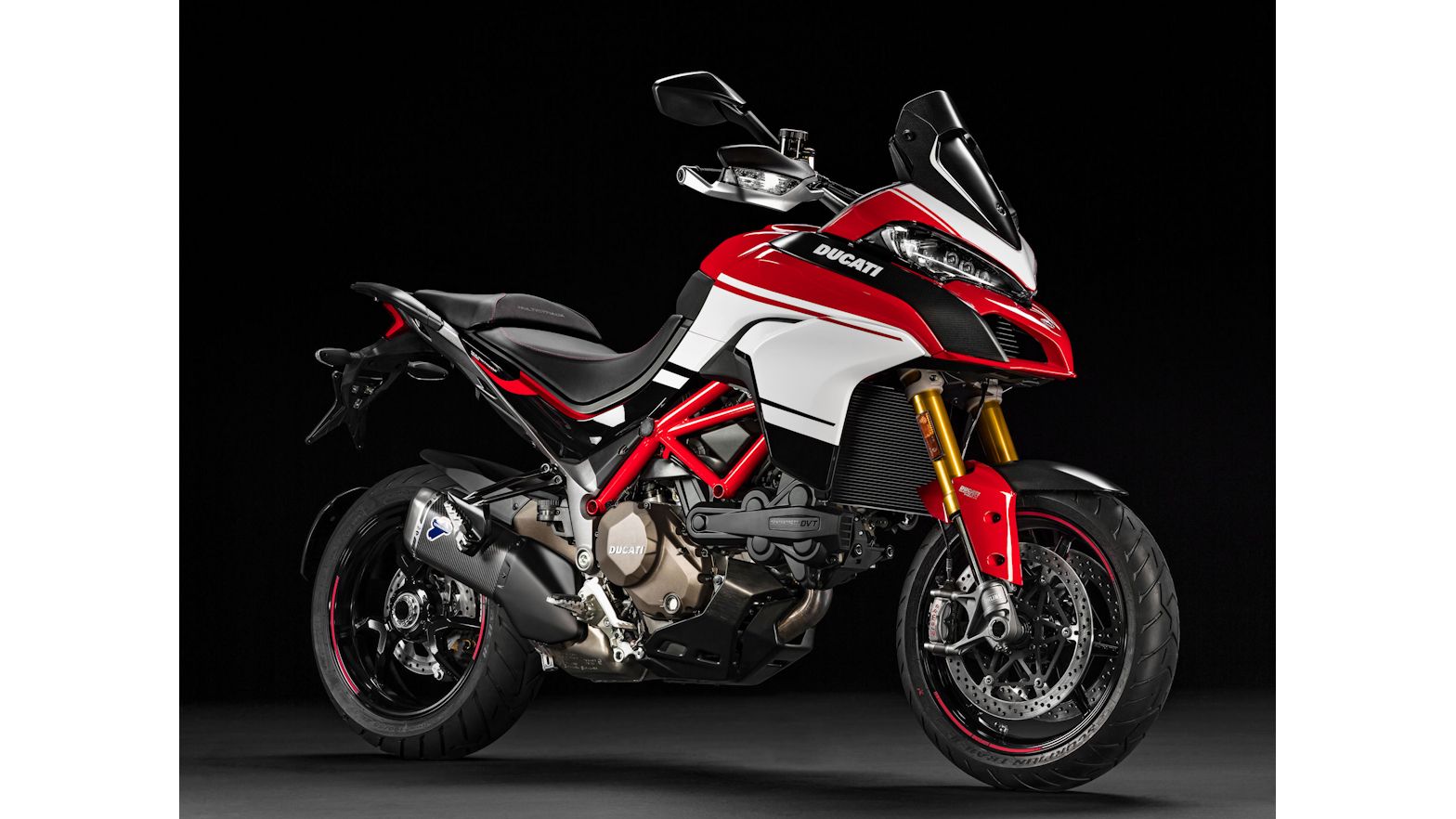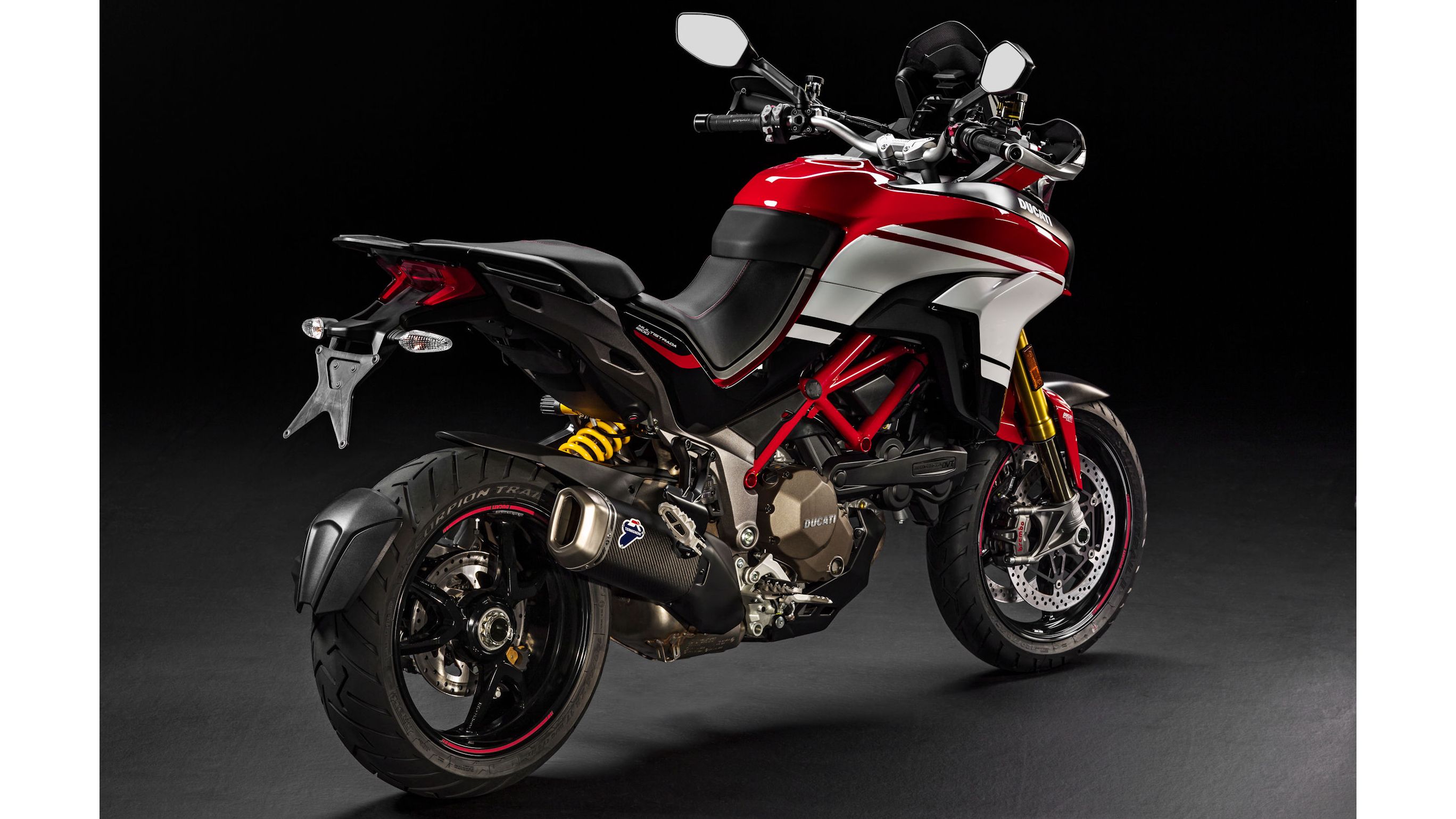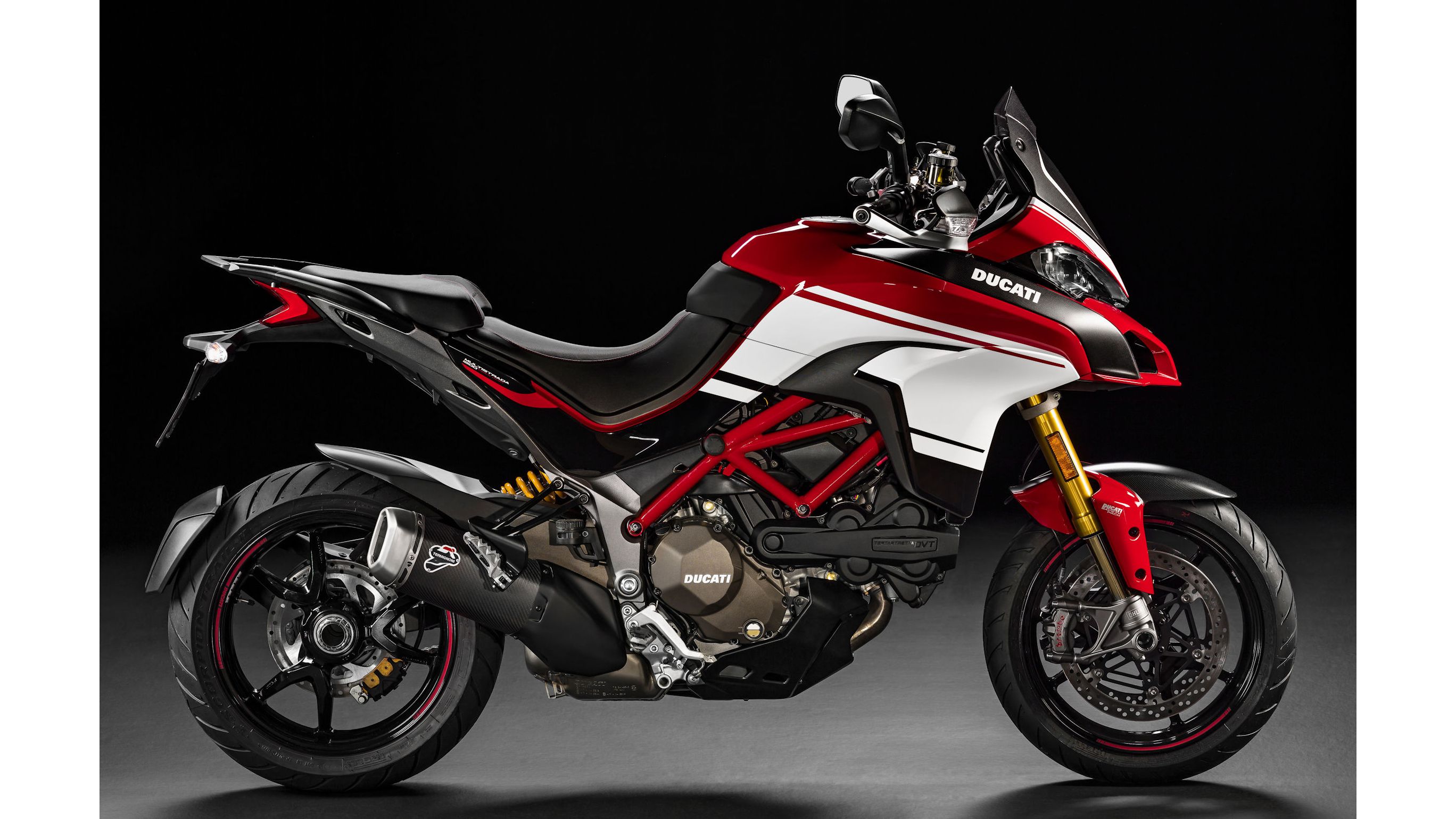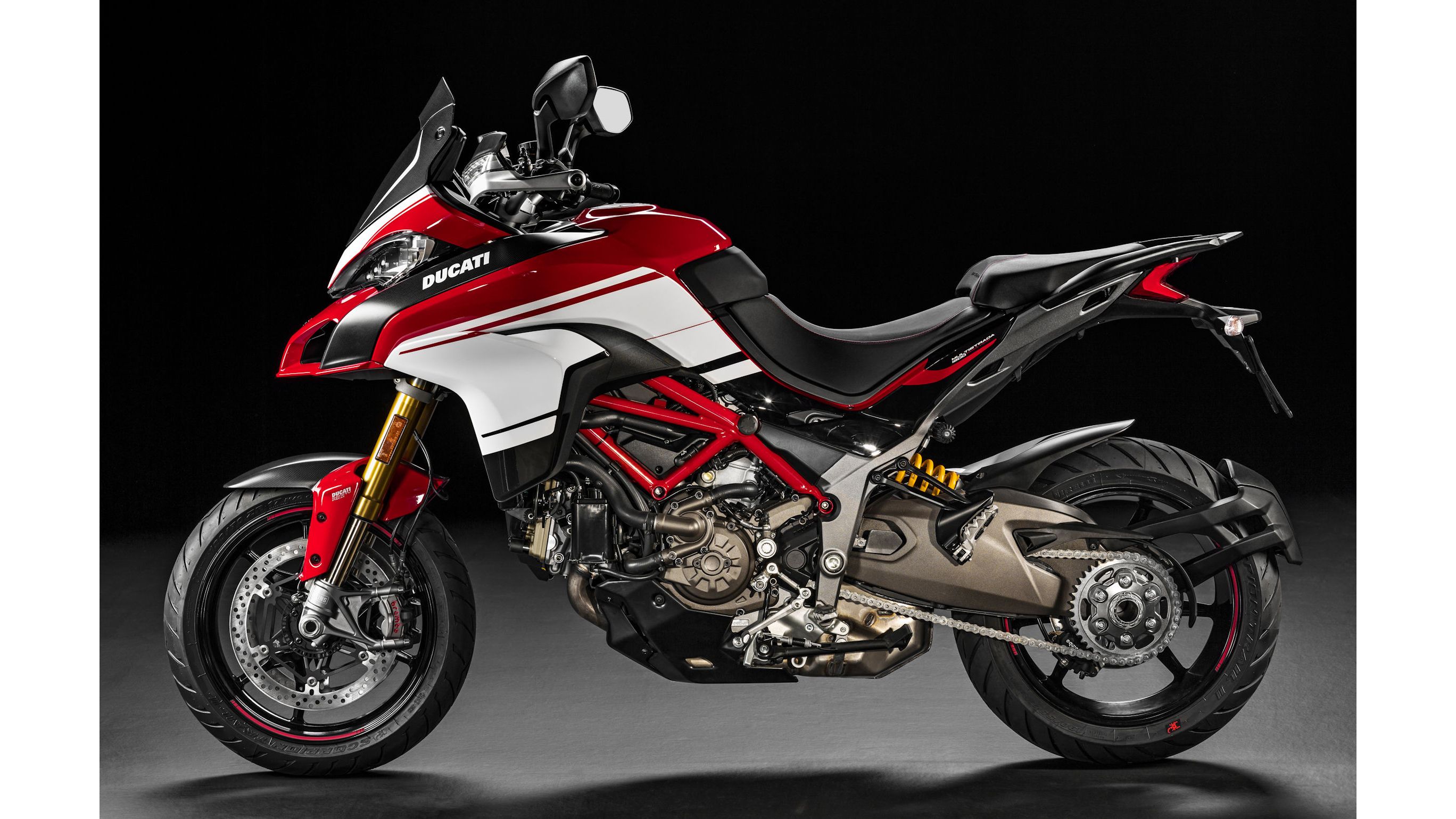Two new members arrive in the Ducati Multistrada->ke1936 1200 stable for 2016: the Enduro and the Pike's Peak. Breaking with tradition, Ducati->ke622 jumps with both feet into the adventure market with a tried-and-true Multistrada base and gives us a truly off-road->ke450-capable performance machine in the Enduro and a nod to hill-climb racing->ke2345 success with the Pike's Peak.
They might have the same DVT engine and the same basic chassis, but with so many updates and upgrades, these two 1200s are really in their own class. In short, these aren't your dad's Multistrada.
Continue reading for my review of the Ducati Multistrada 1200 Endure and Multistrada 1200 Pike's Peak.
2016 Ducati Multistrada 1200 Enduro / Pike's Peak
- Make: Array
- Model: 2016 Ducati Multistrada 1200 Enduro / Pike's Peak
- [do not use] Vehicle Model: Array
Design
If you've ever been on the top of Pike's Peak as I have, you know the view is spectacular on a clear day. The trick is, you have to get up there -- no small feat even if you aren't racing. As a nod to Ducati's success in the Pikes Peak International Hill Climb -- one of the most famous hill-climb races in the world -- with the Multstrada 1200, they bring us the Pike's Peak model with its racing livery to underscore its success on the mountain.
With a shorter first gear and a shorter sixth gear, there's more torque through the rev- range; add street knobbies and you're ready for pavement or dirt. Taller suspension than its base-model stablemate, the Multistrada, and with more suspension travel, the 1200 Enduro may seem a little squishy on the road, but once you get used to it, it really is a proper tourer->ke2669.
While looking over these bikes, one feature really caught my attention. A series of LEDS on the fairing abreast of the headlight illuminate the road as you turn so you have light into the turn and don't have to wait for your headlight to finish its swing so you can see what's in front of you. It's not a big deal, but it's a really nice feature if you're used to riding at night without the benefit of streetlights.
Chassis
Minimal body panels and skidplates leave no doubt as to the type of frame we have here; it's a stressed-engine Trellis setup. This is a good foundation for an adventure bike, since the Trellis is strong, light and rigid, and the steel members have just enough give to introduce a little extra shock absorption to the system. The Multistrada 1200 Enduro probably benefits more from this last detail since the Pikes Peak is set up more for its namesake, uphill road race.
Steering geometry differs slightly between the Enduro and the Pikes Peak, with the latter carrying a 24-degree rake angle and the former a 25-degree angle. This discrepancy is easily explained by the difference in front fork length, and there must be an offset in the fork lowers as well since both rides have the same 4.3 inches of trail.
The Enduro rolls on a 19-inch front rim and a 17-inch rear, obviously for greater off-road performance, but the stock bikes come with Pirelli Scorpion Trail II tires geared toward road work. For those of you looking to take the Enduro model on true, off-road adventures, Ducati offers the Pirelli Scorpion Rally tires, a sort of street knobby with deep grooves and wide street flats for dual-purpose riding, you know, like you would expect to do on a bike with an enduro-racing bent.
Now for the fork difference; Ducati runs a set of Sachs 48 mm forks in the traditional, right-side-up configuration on the Enduro, and it comes not only with a longer overall length, but a longer stroke than the Pikes Peak at 7.9 inches. The rear suspension on the Enduro likewise comes with a 7.9-inch stroke from the Sachs monoshock, and both ends benefit from the Ducati Skyhook Suspension (DSS) feature, more on that later.
Suspension components on the Pikes Peak come set up for a more street-wise ride. Öhlins, 48 mm usd front forks and TTX36 monoshock attend the damping duties, and provide a uniform 6.7 inches of travel front and rear. Like the Sachs suspension on the Enduro, the Öhlins falls under the management of the DSS, a marvel of engineering that monitors lean angle, speed and other metrics, then electronically adjusts the damping values for a ride that can provide a soft ride that doesn't dive excessively under heavy braking, and actively protects the integrity of the contact patch. Best of all, both the front and rear ride can be adjusted on the fly from the handlebar-mounted thumb buttons.
Both rides come with a 265 mm disc and twin-pot caliper in back, and carry Brembo, four-bore, Monobloc calipers up front, but where the Enduro carries a pair of 320 mm discs, the Peak pushes front brake disc diameter out to 330 mm; just about as big as they get. All of the brakes across the board come with cornering ABS as part of the standard package for a little extra traction protection.
The final bit of magic in the brake system concerns the Ducati Hold Control feature that allows you to temporarily set a brake, as on an incline, and let got of the front brake lever prior to takeoff. This will pay for itself the first time you have to come to a stop on an incline, especially if you are heavily laden with gear and a passenger.
Drivetrain
One feature that's consistent across the board is the 1,198 cc, Testastretta L-Twin mill used to power these Multistrada siblings. Boasting the Ducati Desmodromic valvetrain with variable valve timing (DVT), these liquid-cooled mills describe what most Westerners would call a 90-degree V-twin, and each bore measures out at 106 mm by 67.9 mm for a decidedly short-stroke engine.
While V-twins are more famous for their torque numbers than horsepower, this plant represents an exception to the rule. It churns out plenty of torque with 100.3 pound-feet at 7,500 rpm, but it really shines in the horsepower department. At 9,500 rpm, a total of 160 ponies gets unleashed from the stable, and you had better be hanging on.
Part of this power comes from the hydraulically actuated variable cam timing that rotates the shaft independent of the drive sprockets for dynamic tuning throughout the rev range. The ride-by-wire butterfly in the elliptical, fuel-injected throttle bodies enables a number of features. Namely, the Ducati Wheelie Control (DWC), Traction Control (DTC) and Power Modes (PM) that allow you to tailor your ride and customize the level of automatic intervention to help you keep the bike under control. Good thing too, given the kind of numbers coming from the engine.
A final effort from the factory to protect the contact patch integrity shows up in the clutch; namely it is of the hydraulic-assist “slipper” clutch variety designed to limit back-torque and prevent loss of rear-wheel grip during aggressive downshifts. The six-speed transmission and chain drive handle the final drive ratios.
Pricing
MSRP looks like it's coming in at $21,295 for the Multistrada 1200 Enduro in Phantom Grey, Star White Silk or red and $23,795 for the Pike's Peak in snazzy red with stripe livery.
Competitors
Usually I like to match engine size when making a comparison as it seems more conductive to keeping apples to apples. There are certainly choices out there in the 1,200 cc adventure market such as the R 1200 GS from BMW->ke1398, the Caponard 1200 GS Rally from Aprilia->ke1934, or the Super Ténéré->ke4422 from Yamaha->ke301; any of which would be worthy competitors.
I'm feeling a little adventurous today, though, so let's look at the Africa Twin from Honda->ke291. Why? The Africa Twin is a relative newcomer to the adventure market and I want to look at these two new kids on the block, so to speak.
I want to get down to the powerplants right off the bat. Ducati has a good reputation for solid engines, but so does Honda, so let's see how they stack up. First off, the Ducati comes out the larger of the two at 1,198.4 cc, a bit over the 998 cc Africa Twin, and this carries directly over into the performance profiles. Honda falls a little short with 95 ponies and 72 pounds of grunt versus the crushing 160 horsepower and 100.3 pound-feet, a bit more of a difference than can be explained away by displacement alone.
Both rides come with some form of variable engine output curve or rider mode, slipper clutch and adjustable ABS, but while the Enduro sports a fancy dynamic suspension system, Honda took the unusual step of offering an automatic transmission as one of the available options. In the end, Ducati offers a few more electronic control features, which is all great and fine until one of these complicated systems need to be worked on.
Looks-wise the Enduro cuts a typical figure with a bird's beak fairing and poised-to-pounce stance, and the Africa Twin fits the mold as well, but with a blunt entry to the front fairing that leads with the headlights. Unfortunately, a lack of cornering lights on the Honda leaves the Ducati Enduro more suited to night-time work. Beyond that, both of these models can be ridden while standing, an important feature for close-quarters maneuvering around bumpy terrain and unimproved trails.
Overall, the Enduro is a bit more bike, but you are going to pay through the nose for the differences you get. The Africa Twin starts at $12,999 MSRP for the base model, and $13,699 for the DCT-equipped model, while the Ducati Enduro rolls for a lofty $21,285 for a shocking difference at the till.
He Said
My husband and fellow writer, TJ Hinton, says, “Good looking ride, and as usual Duc hands us what looks to be a top notch product. Given the frenzy to capture a slice of the dual-sport market, I expect that many won't be turned off by the price on the Duc. I believe that if you pay for the best, you are rarely disappointed, and I would feel comfortable gambling on the Ducati, you know, IF money were no object.”
She Said
“Looking at the adventure market, the Multistrada 1200 Enduro is significantly more expensive than the 1,200 cc competitors like the R 1200 GS, Caponard 1200 Rally and the Super Ténéré. Italian tech-alphabet soup, though, can make for an impressive piece of machinery. When the Multistrada was introduced in 2003 it was not initially intended for off-road use. That changed with the Multistrada 1200 in 2010. I'm glad to see the family expanding into the growing adventure market, but can it be competitive at that price? It really is a lot of bike for the money, though and once you get a load of these Multistradas, you might not want to go back.”
Specifications
|
Model: |
Multistrada 1200 Enduro |
Multistrada 1200 Pike's Peak |
|
Engine: |
||
|
Type: |
Testastretta with variable valve timing, L-Twin cylinder, 4 valve per cylinder, Dual Spark, Desmodromic, liquid cooled |
Ducati Testastretta DVT with Desmodromic Variable Timing, L-Twin cylinder, 4 valve per cylinder, Dual Spark, liquid cooled |
|
Displacement: |
1198.4cc |
1198.4cc |
|
Bore x Stroke: |
106x67.9mm |
106 x 67.9 mm |
|
Compression ratio: |
12.5:1 |
12.5:1 |
|
Power: |
160hp - 117.7kw @ 9500rpm |
117.7 kW (160 hp) @ 9,500 rpm |
|
Torque: |
136 Nm (13.9 kgm) @ 7,500 rpm |
136 Nm (100.3 lb-ft) @ 7,500 rpm |
|
Fuel injection: |
Bosch electronic fuel injection system, elliptical throttle bodies with Ride-by-Wire, equivalent diameter 56 mm |
Bosch electronic fuel injection system, elliptical throttle bodies with Ride-by-Wire, equivalent diameter 56 mm |
|
Exhaust: |
Stainless steel muffler with catalytic converter and 2 lambda probes, single stainless steel muffler |
Stainless steel muffler with catalytic converter and 2 lambda probes, aluminium tail pipes |
|
Transmission: |
||
|
Gearbox: |
6 speed |
6 speed |
|
Primary drive: |
Straight cut gears, Ratio 1.84:Straight cut gears, Ratio 1.84:1 |
|
|
Ratio: |
1=37/15 2=30/17 3=27/20 4=24/22 5=23/24 6=22/25 |
1=37/15 2=30/17 3=27/20 4=24/22 5=23/24 6=22/25 |
|
Final drive: |
Chain; Front sprocket 15; Rear sprocket 43 |
Chain; Front sprocket 15; Rear sprocket 40 |
|
Clutch: |
Light action, wet, multiplate clutch with hydraulic control. Self-servo action on drive, slipper action on over-run |
Light action, wet, multiplate clutch with hydraulic control. Self-servo action on drive, slipper action on over-run |
|
Chassis: |
||
|
Frame: |
Tubular steel Trellis frame |
Tubular steel Trellis frame |
|
Front suspension: |
Sachs 48 mm fully adjustable usd forks. Electronic compression and rebound damping adjustment with Ducati Skyhook Suspension (DSS) |
Öhlins 48 mm fully adjustable usd fork with TiN treatment |
|
Front wheel: |
Tubeless spoked wheel in light alloy 3" x 19" |
Y-shaped 3-spoke in light alloy, 3.50" x 17" |
|
Front Tyre: |
Pirelli Scopion Trail II 120/70 ZR19 as optional Pirelli Scorpion Rally same measure |
Pirelli Scorpion Trail II 120/70 ZR17 |
|
Rear suspension: |
Fully adjustable Sachs unit. Electronic compression & rebound damping adjustment. Electronic spring pre-load adjustment with Ducati Skyhook Suspension (DSS). Aluminium double-sided swingarm |
Fully adjustable Öhlins TTX36 unit. Aluminium single-sided swingarm |
|
Rear wheel: |
Tubeless spoked wheel in light alloy 4.50" x 17" |
Y-shaped 3-spoke in light alloy, 6.00" x 17" |
|
Rear tyre: |
Pirelli Scorpion Trail II 170/60 ZR17 as optional Pirelli Scorpion Rally same measure |
Pirelli Scorpion Trail II 190/55 ZR17 |
|
Front wheel travel: |
200 mm (7,9 in): |
170mm (6.7in) |
|
Rear wheel travel: |
200 mm (7,9 in) |
170mm (6.7in) |
|
Front brake: |
2 x 320 mm semi-floating discs, radially mounted monoblocco Brembo callipers, 4-piston, 2-pad, with cornering ABS as standard equipment |
2 x 330 mm semi-floating discs, radially mounted Brembo Monobloc Evo M50 4-piston callipers, 2-pad, radial pump with cornering ABS as standard equipment |
|
Rear brake: |
265 mm disc, 2-piston floating calliper, with cornering ABS as standard equipment |
265 mm disc, 2-piston floating calliper, cornering ABS as standard equipment |
|
Instrumentation: |
Color TFT display 5" |
Colour TFT display 5" |
|
Dimensions and weight: |
||
|
Dry weight: |
225 kg (8.8 in) |
208 kg (458 lb) |
|
Wet weight: |
254 kg (560 lb) |
231 kg (509 lb) |
|
ABS wet weight: |
N/A N/A |
|
|
Seat height: |
Not adjustable 870 mm (890 - 850 mm with optional seats) |
Adjustable: 825 - 845 mm (32.5 - 33.3 in) |
|
Wheelbase: |
1594 mm (62.76 in) |
1,529 mm (60.2 in) |
|
Rake: |
25° |
24° |
|
Trail: |
110 mm (4.3 in) |
109 mm (4.3 in) |
|
Fuel tank capacity: |
30l - (7.9 US gal) |
20l - 5.3 gallon (US) |
|
Number of seats: |
Dual seat |
Dual seat |
|
Standard Equipment: |
||
|
Standard Equipment: |
Riding Modes, Power Modes, Cruise control, ABS cornering, DTC and DWC, RbW, Hands-Free, Full Led headlamp with light cornering function, bluetooth modul for infotainment |
Riding Modes, Power Modes, Ducati Safety Pack (cornering ABS + DTC), Ducati Wheelie Control, cruise control, full LED headlamp with Ducati Cornering Lights, hands-free, bachlit handlebar switches, bluetooth modul for multimedia system |
|
Warranty: |
||
|
Warranty: |
24 months unlimited mileage |
24 months unlimited mileage |
|
Maintenance service intervals: |
15,000 km (9.000 m) / 12 months |
15,000 km (9,000 mi) / 12 months |
|
Valve clearance check: |
30.000km (18,000m) |
30,000 km (18,000 mi) |
|
Details: |
||
|
Colors: |
Phantom Grey, Star White Silk, Red |
Red with Stripe Livery |


